NocoBase vs NocoDB: An In-Depth Comparison of Open Source No-Code Tools
 Lucy Zhang
Lucy Zhang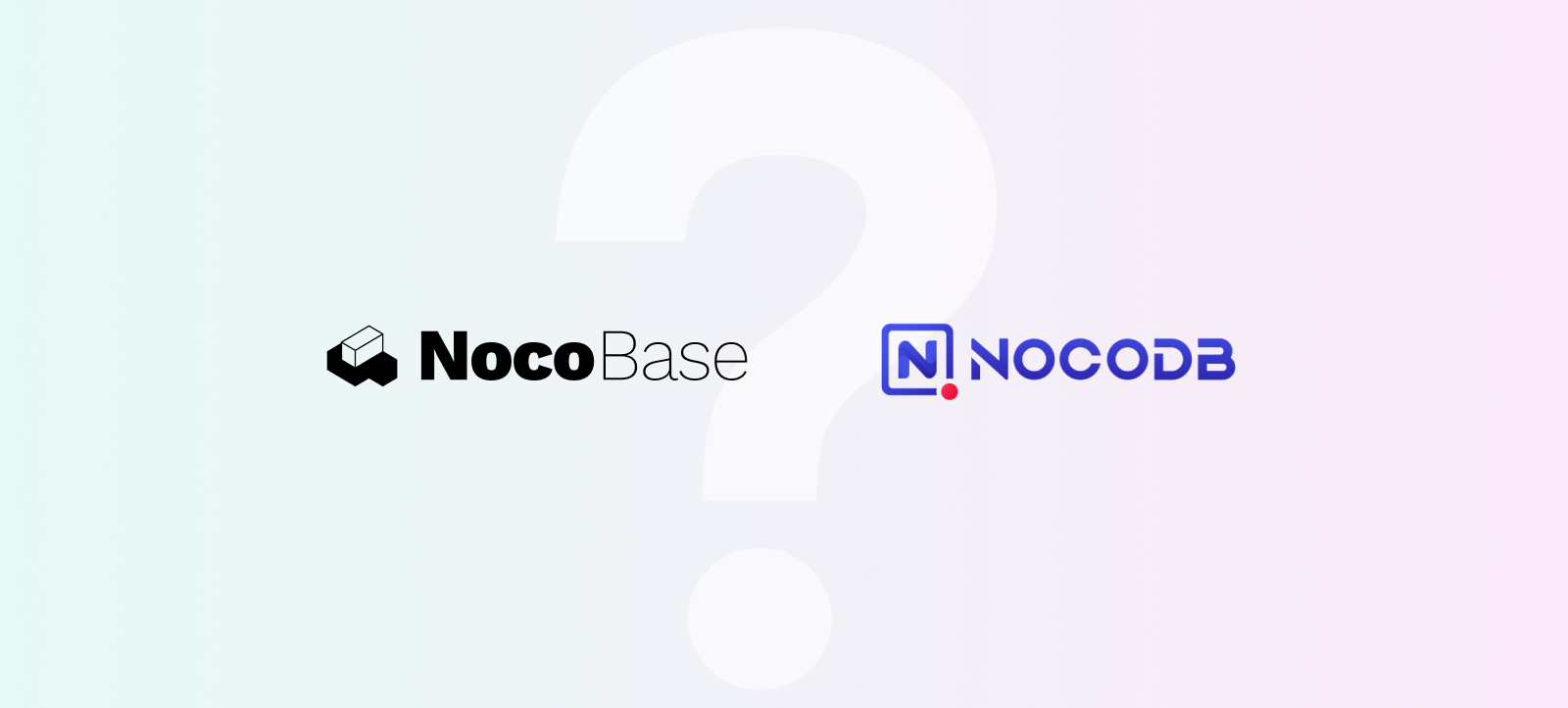
Originally published at NocoBase vs NocoDB: An In-Depth Comparison of Open Source No-Code Tools - NocoBase.
Hello everyone, I am Lijia from NocoBase.
Yes, I often receive many questions when I introduce our product, NocoBase.
“What is your relationship with NocoDB?”
“Is NocoDB another product from your company?”
“These names sound so similar; I can’t tell them apart.”
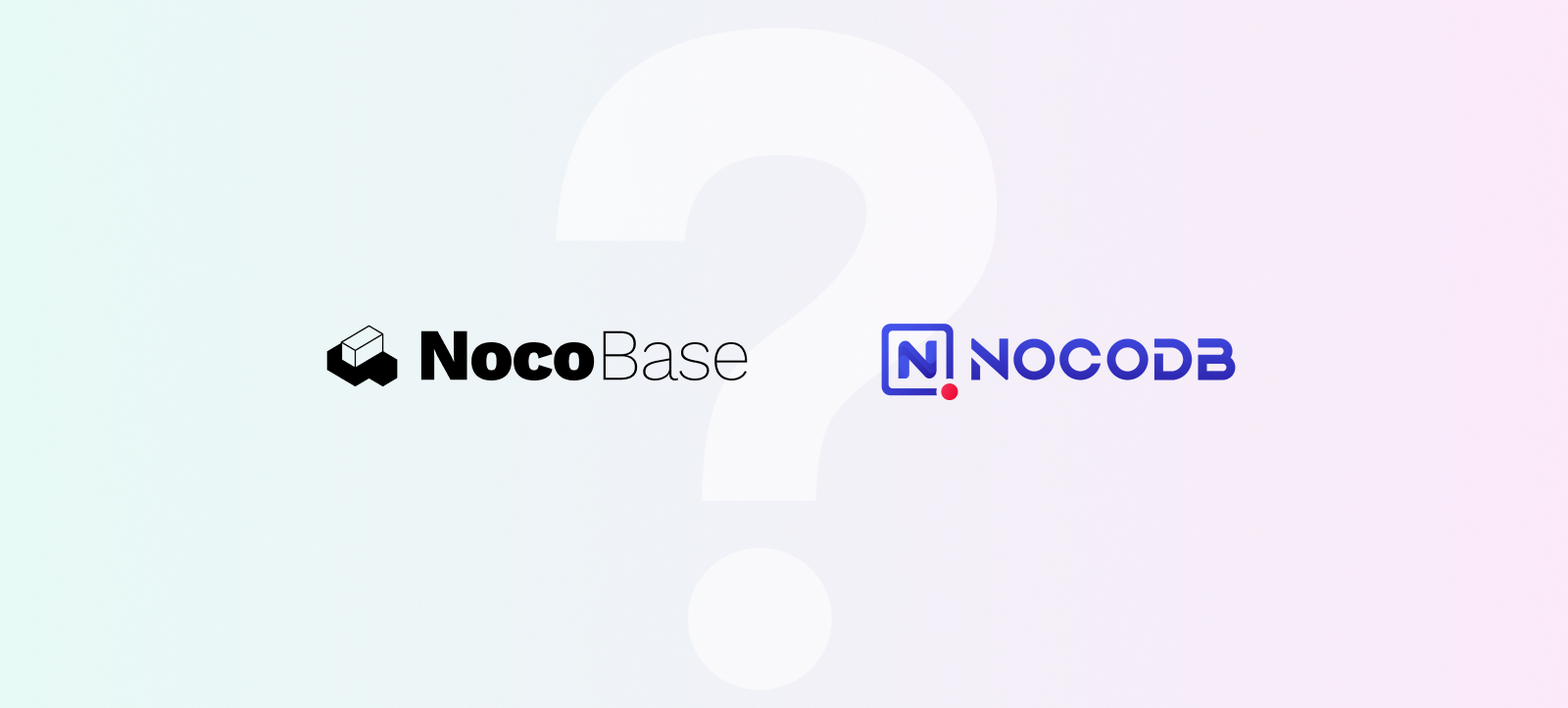
I apologize for any confusion these names have caused.
So today, I will provide a detailed comparison of these two completely different products. In this article, I will show you the distinct use cases for both NocoBase and NocoDB, and how to maximize their potential based on your needs.
This article is quite lengthy, so feel free to skip to the sections you are most interested in:
Introduction to NocoBase and NocoDB
Key Features
User Experience
Application Integration
Security
Enterprise Features
Data Integration Capability
Let’s dive in!
Introduction to NocoBase and NocoDB
Both NocoBase and NocoDB are open-source no-code platforms, but they serve different purposes.
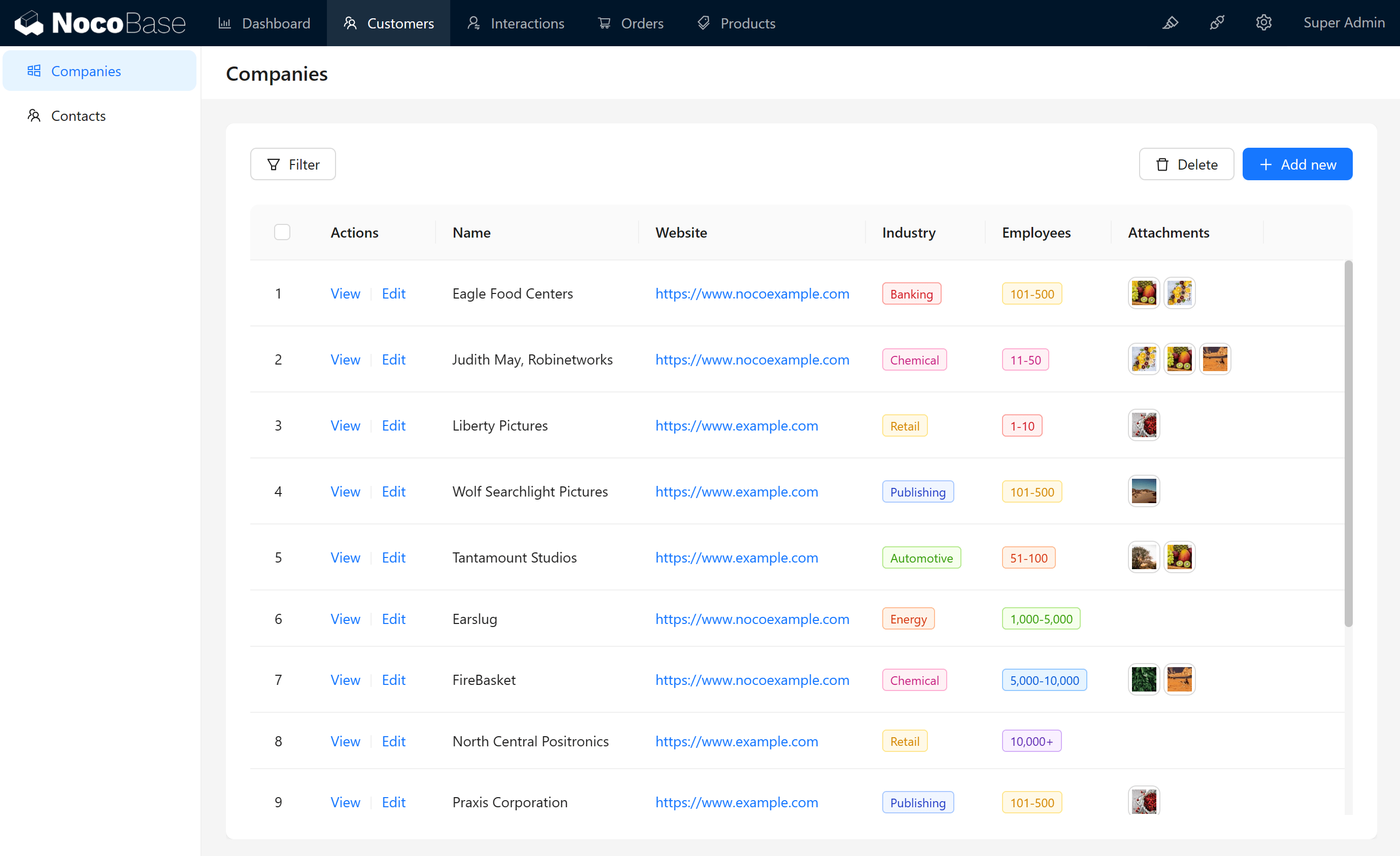
NocoBase is a highly scalable no-code/low-code development platform that allows users to quickly build various business applications. It is built around a data model-driven core, enabling users to design and manage complex workflows through simple configurations.
NocoBase emphasizes flexibility and scalability, providing a strong solution for teams that need a balance between custom development and no-code applications. Users can also extend its functionality with plugins to meet more advanced development requirements.
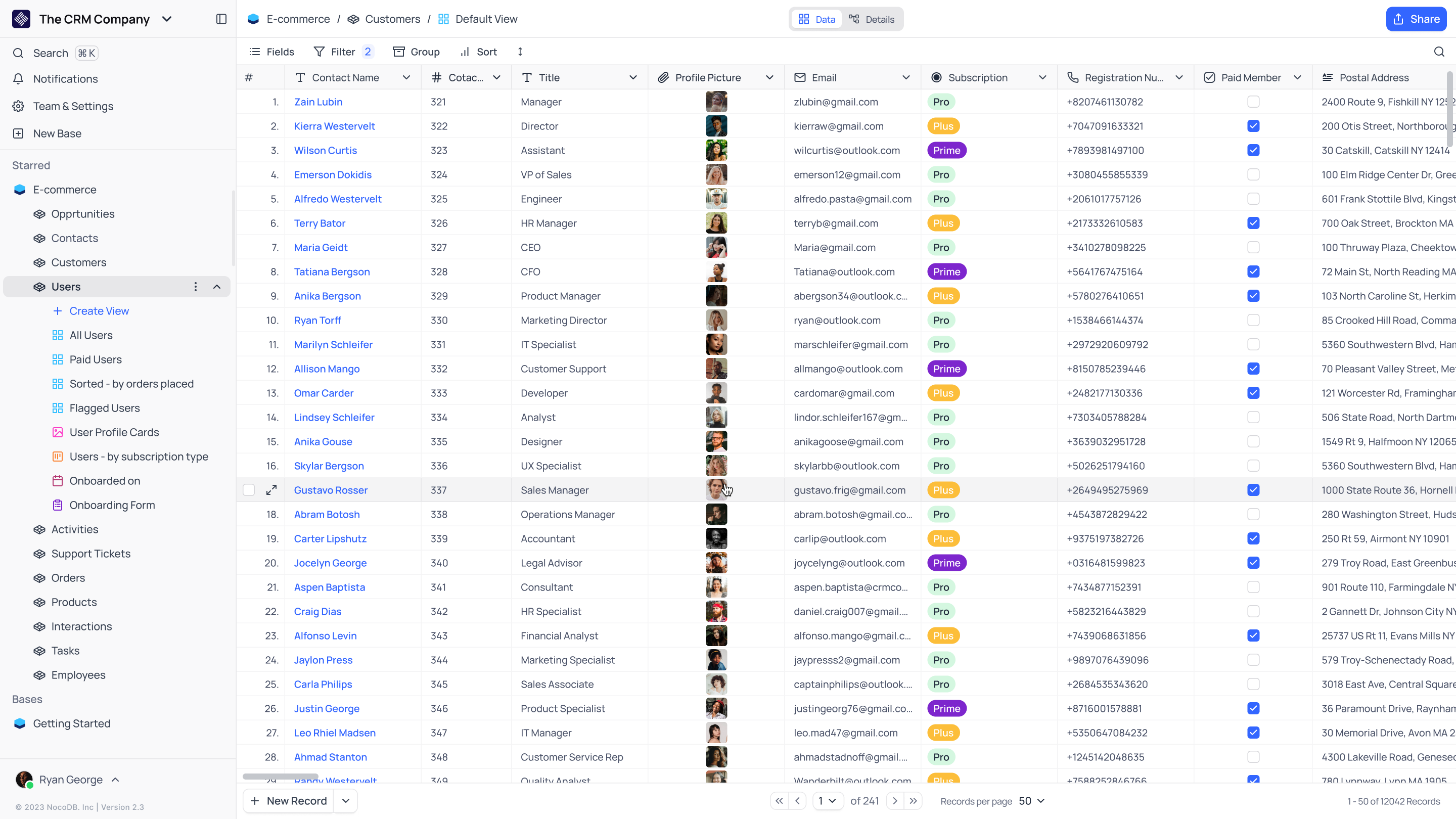
On the other hand, NocoDB focuses on converting existing relational databases into an interface similar to Airtable. Its goal is to simplify database management for users who don’t want to write complex SQL queries.
NocoDB supports databases like MySQL and PostgreSQL, making them easier to work with through a user-friendly interface. While NocoDB excels as a data management tool, it is not a comprehensive application development platform like NocoBase.
In short, NocoBase is a full-fledged application development platform, while NocoDB is a tool focused on managing data.
Despite their similar names, they are designed for entirely different use cases.
Feature Comparison
If you're choosing a no-code tool, the first thing to consider is the feature set.
Below, we'll compare NocoBase and NocoDB across five aspects to help you understand their performance in real-world scenarios.
Form Functionality
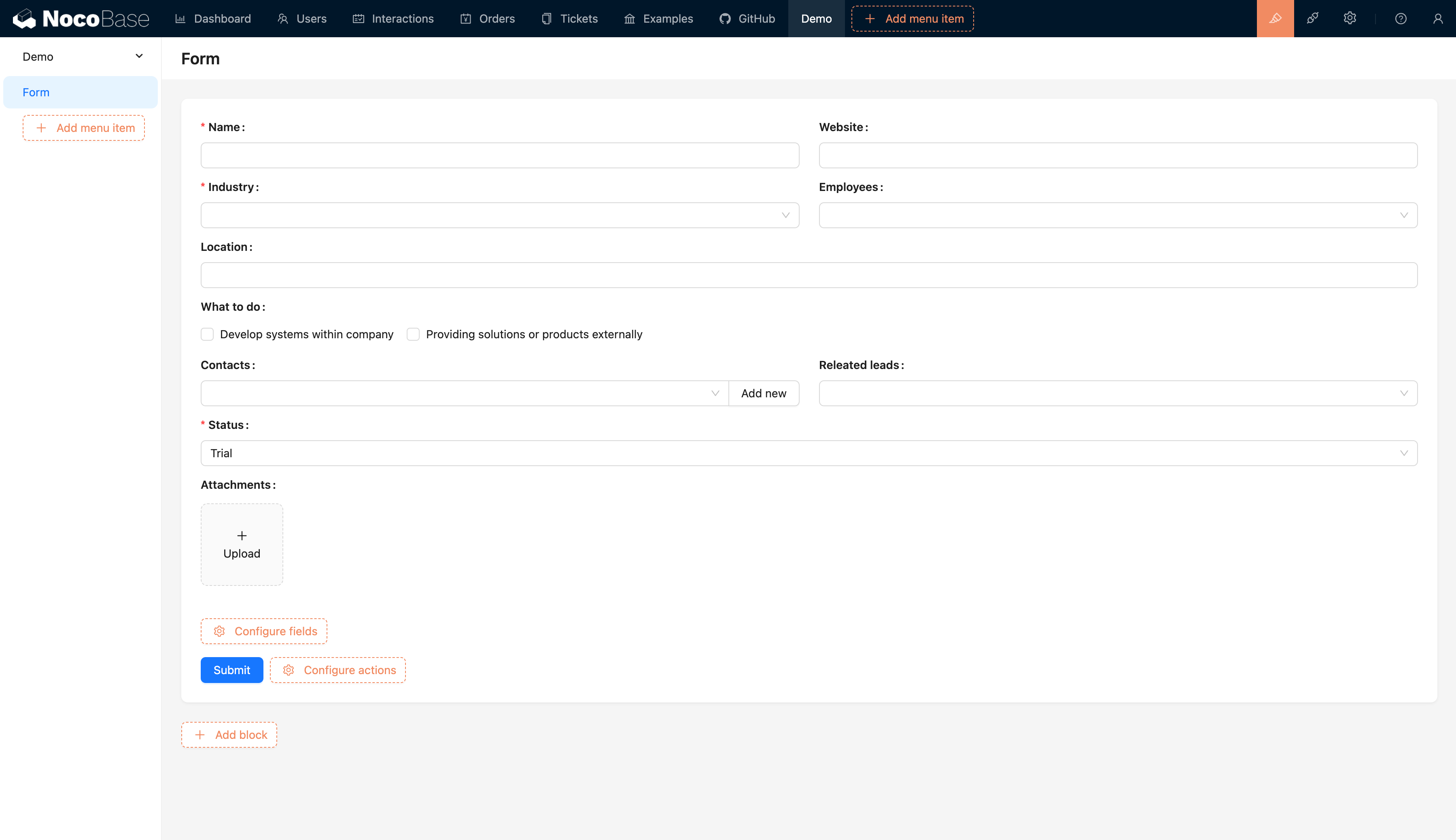
NocoBase provides a flexible and powerful form design feature. Users can easily create various types of forms through a drag-and-drop interface, supporting advanced features like conditional logic, dynamic field displays, and form validation. This makes NocoBase excellent for scenarios requiring complex user input or multi-step forms, especially for applications that need to collect structured data.
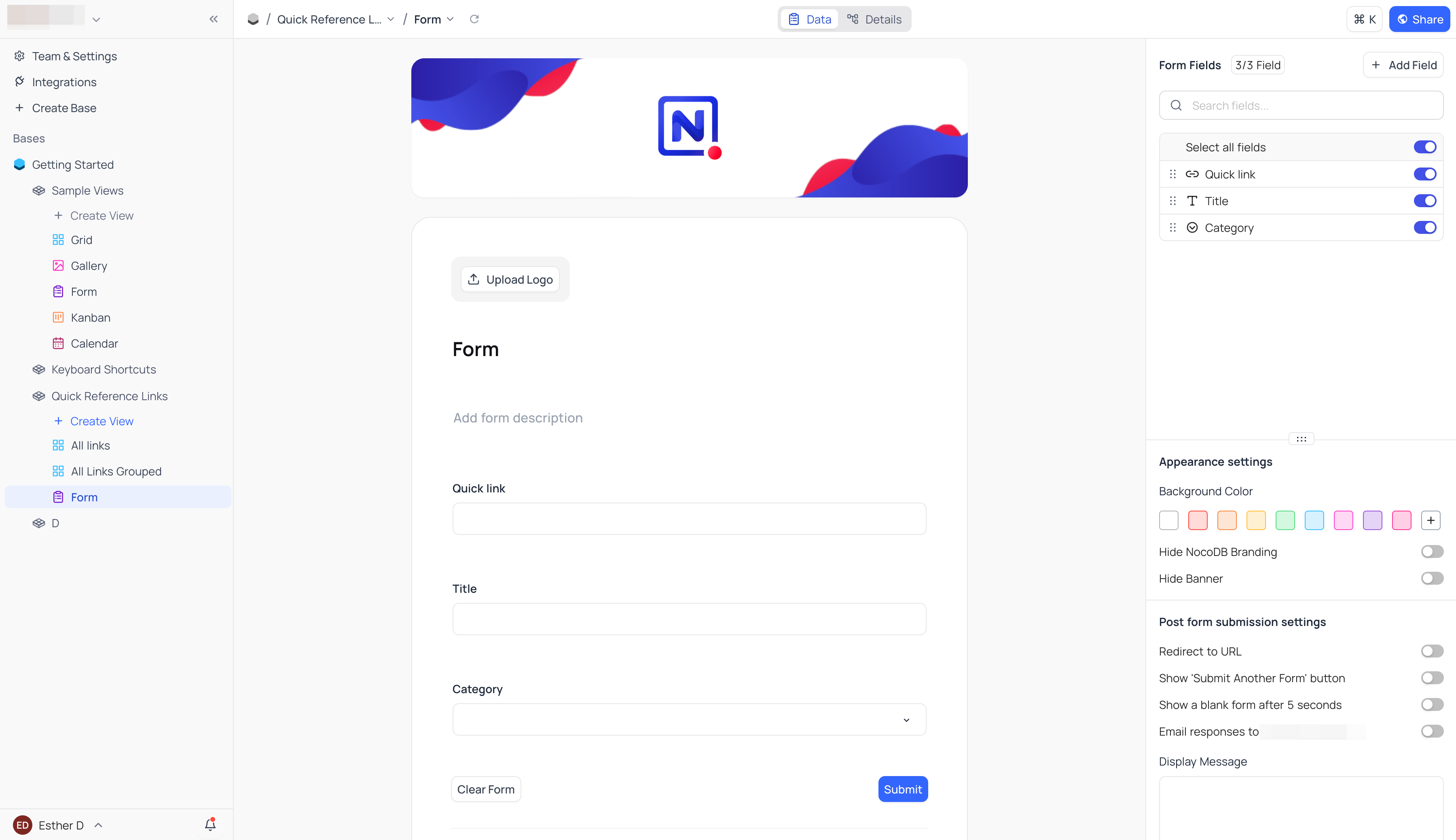
NocoDB's form functionality is simpler. It primarily serves as a data input tool, directly recording data into a database. While the form design is basic, it's sufficient for users who need quick data entry and management.
Automation and Workflow
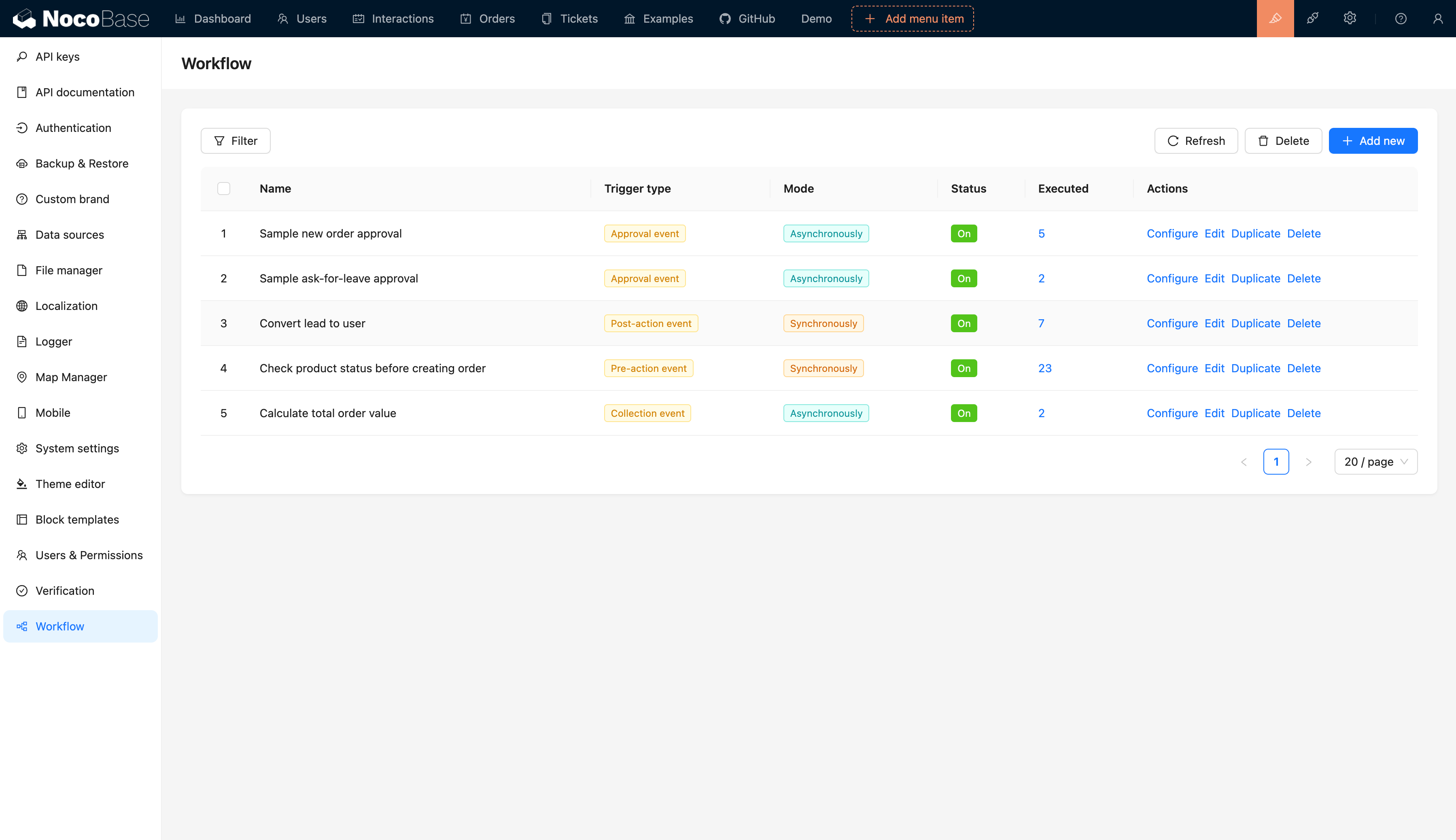
NocoBase comes with a built-in, robust workflow engine. Users can design and automate complex business processes using a graphical interface. From approval flows to notification mechanisms, users can easily configure multi-step operations. Whether it's scheduled tasks or event-driven workflows, NocoBase provides flexibility for enterprise-level applications.
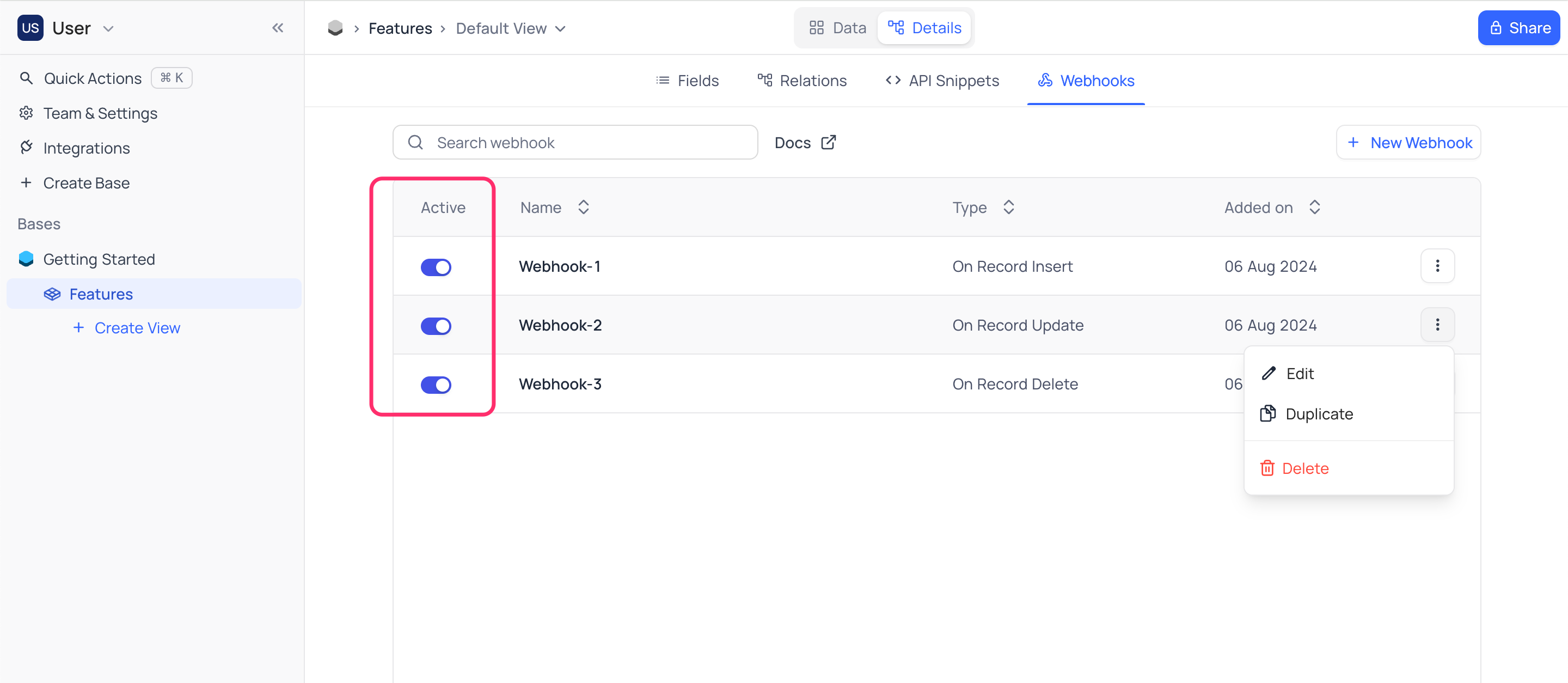
NocoDB, on the other hand, has limited automation features, offering only webhooks for basic automation.
Database Capabilities
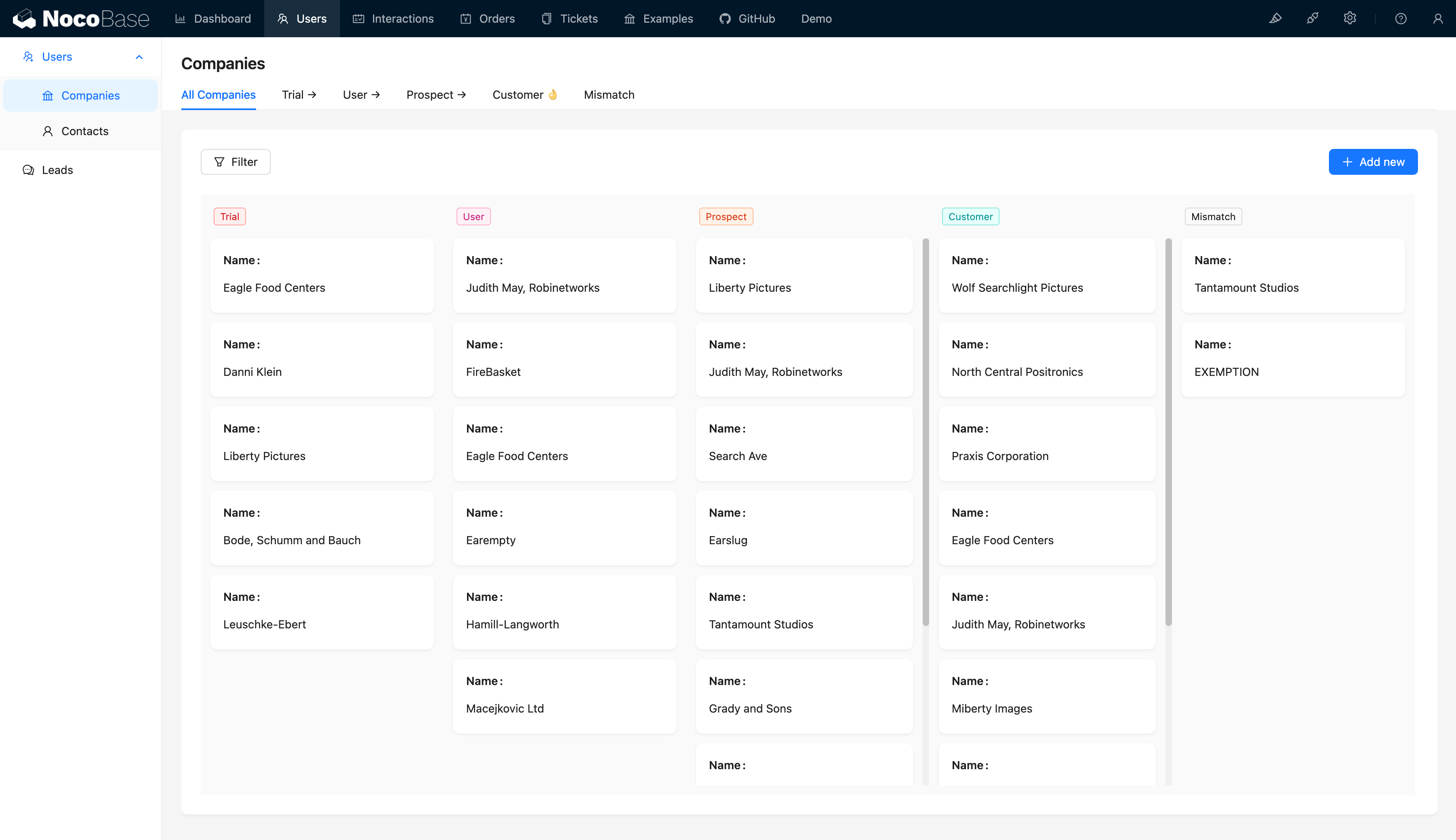
NocoBase is a data model-driven tool, allowing users to define complex data structures based on business needs. It supports not only relational data but also more diverse data types, addressing complex business scenarios.NocoBase's flexible data permission control, combined with front-end blocks, can significantly boost efficiency. Tasks that used to take a full day of development can now be completed in just minutes, delivering impressive results.
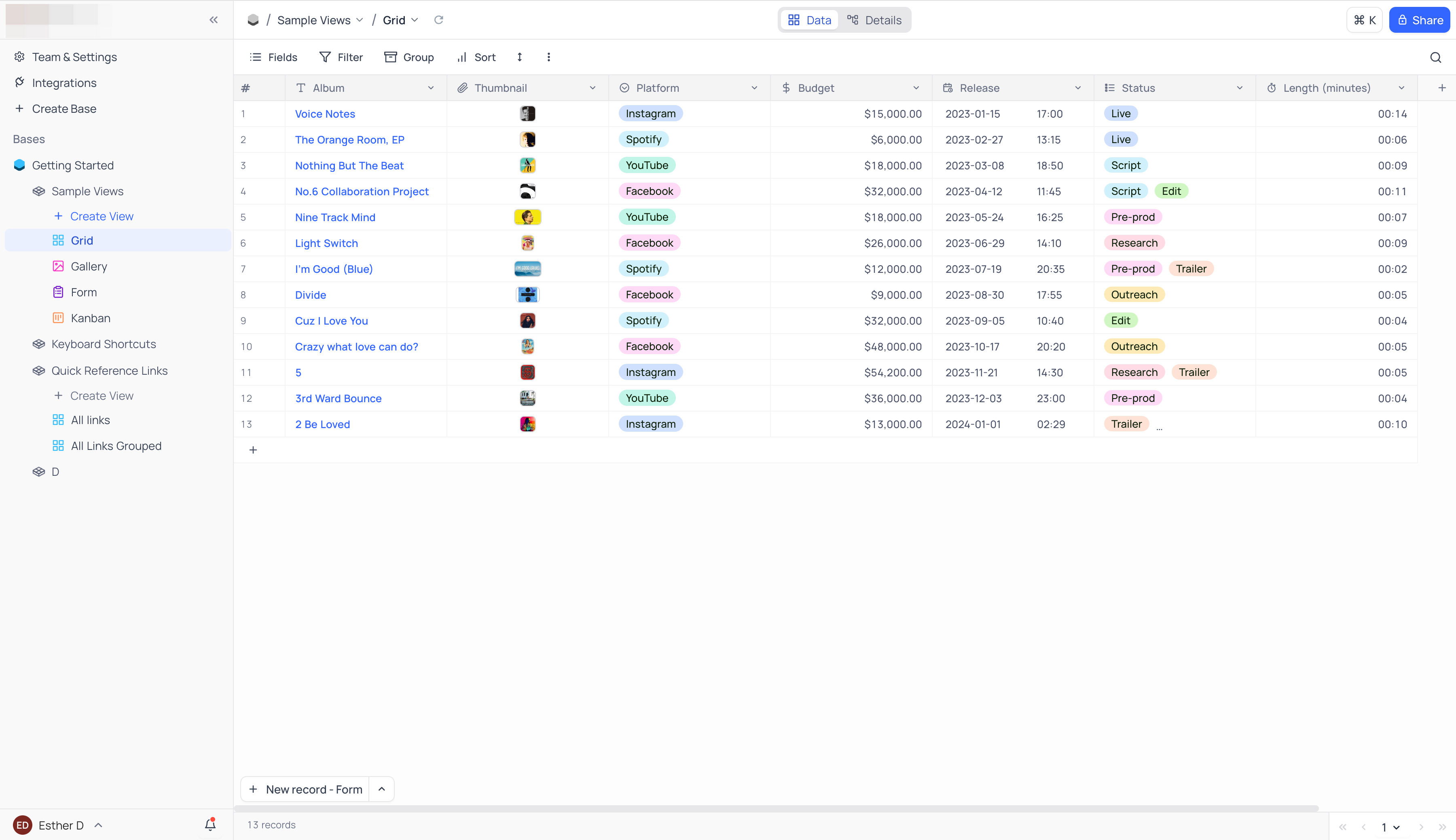
NocoDB focuses on transforming existing relational databases into a visual management tool. Users will enjoy its strong support for table formulas, table relationships, and views, though the API has some limitations and a learning curve. NocoDB is well-suited for users with existing database setups who want a more user-friendly way to manage their data. In comparison, NocoDB is more focused on database management, whereas NocoBase covers a broader scope of application development.
Visual Interface
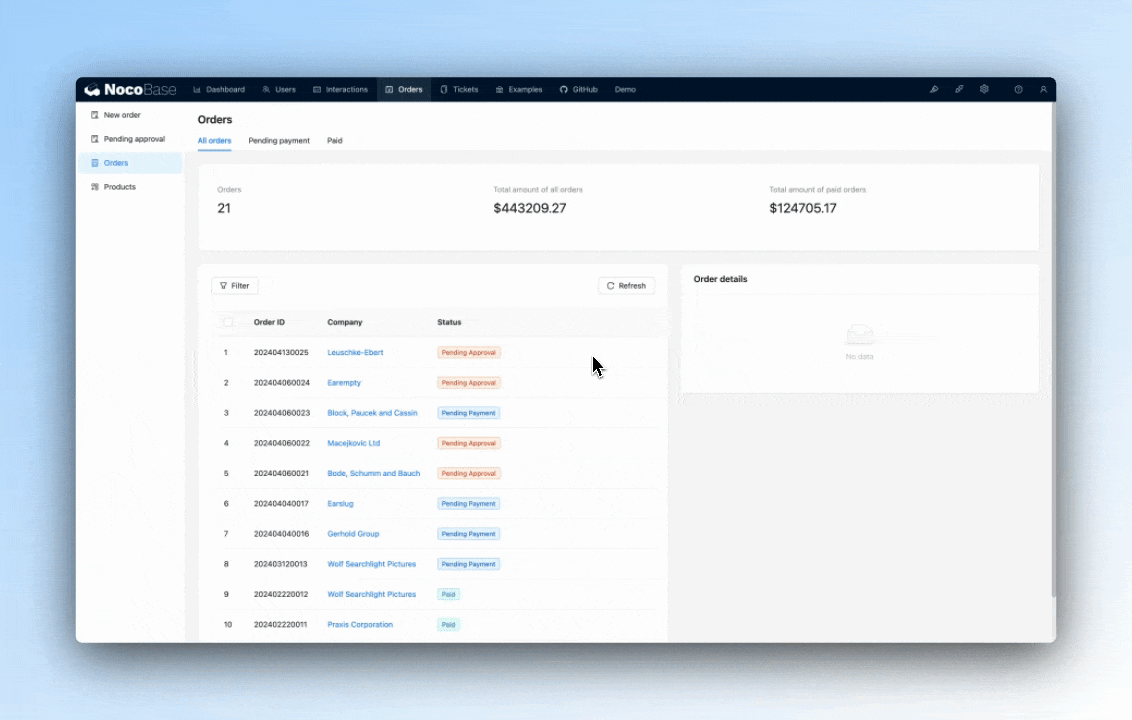
NocoBase offers plenty of flexibility in page and block design. Users can configure interactive filtering between blocks and design page layouts to fit their business needs. It even allows for the creation of complex dashboards and data visualization tools, helping users better analyze and present data. For example, the order details on the right can change dynamically based on the order selected on the left.
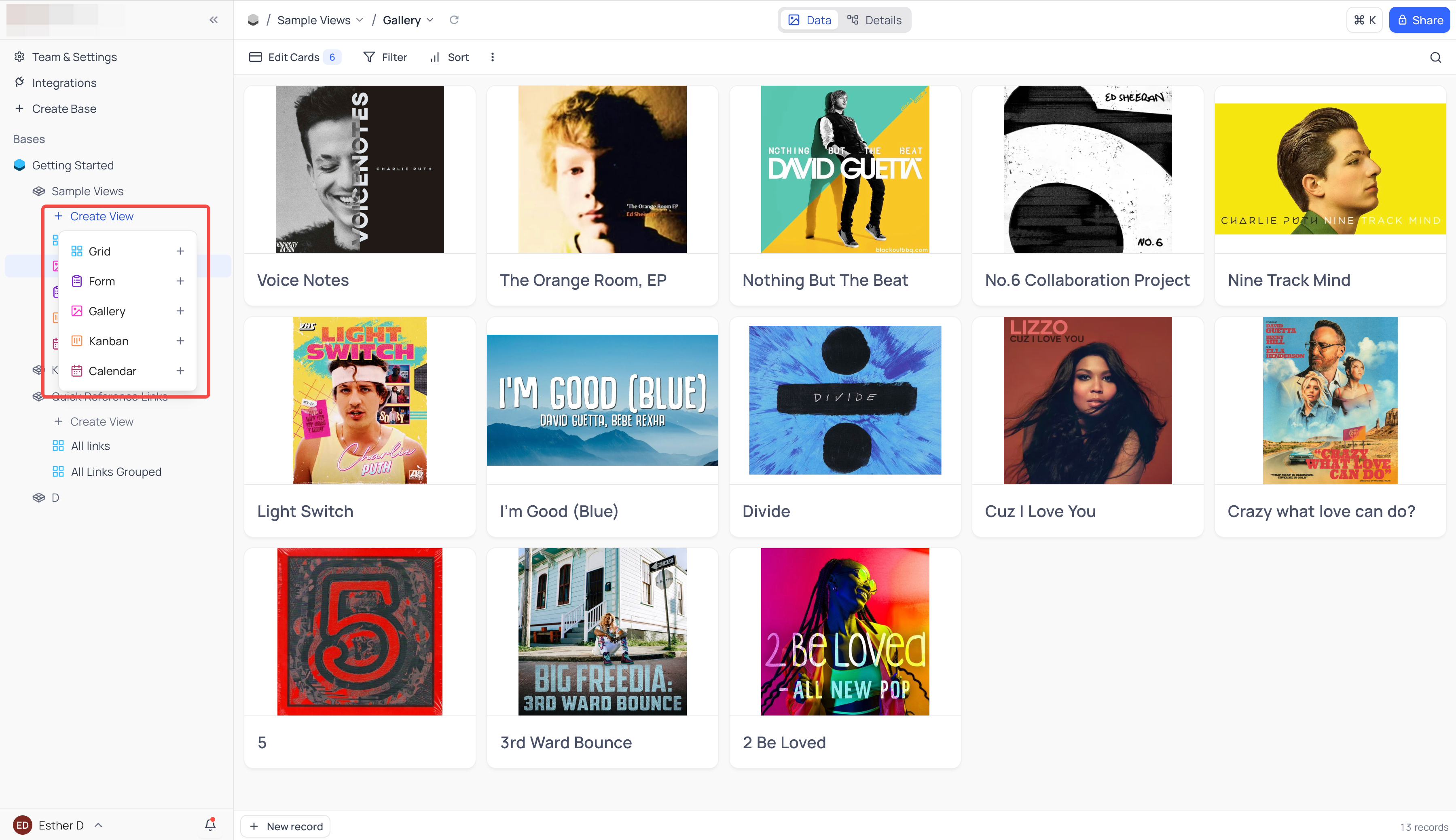
NocoDB, drawing inspiration from tools like Airtable and Notion, mainly provides a grid-like interface for displaying and managing data. While it’s functional for database management, it lacks the flexibility in data visualization and custom interface design that NocoBase offers.
Plugins and Extensions
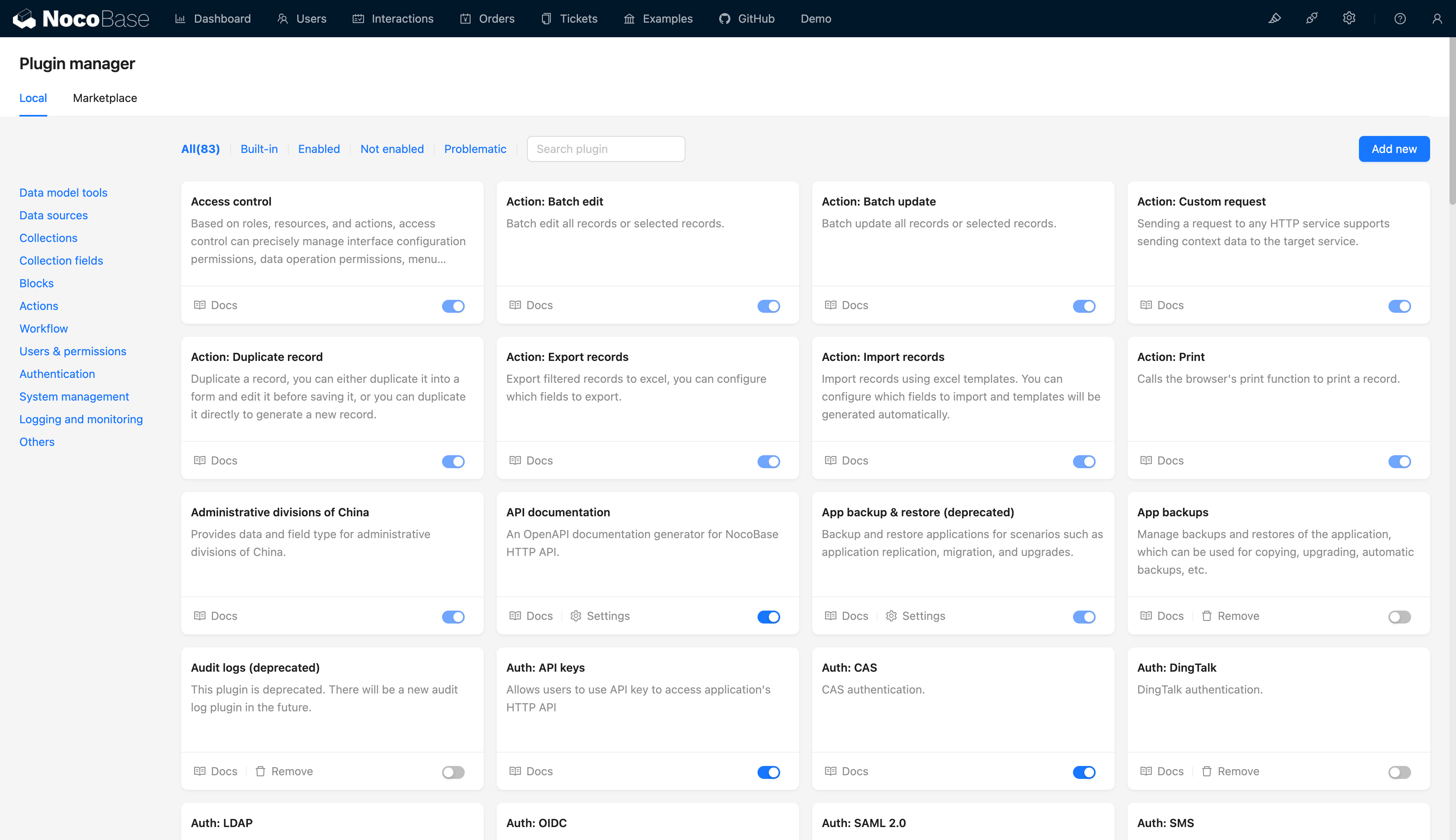
NocoBase uses a plugin architecture, meaning all features can be extended through plugins. Users can choose and install plugins as needed, or even develop their own, significantly enhancing NocoBase’s extensibility.
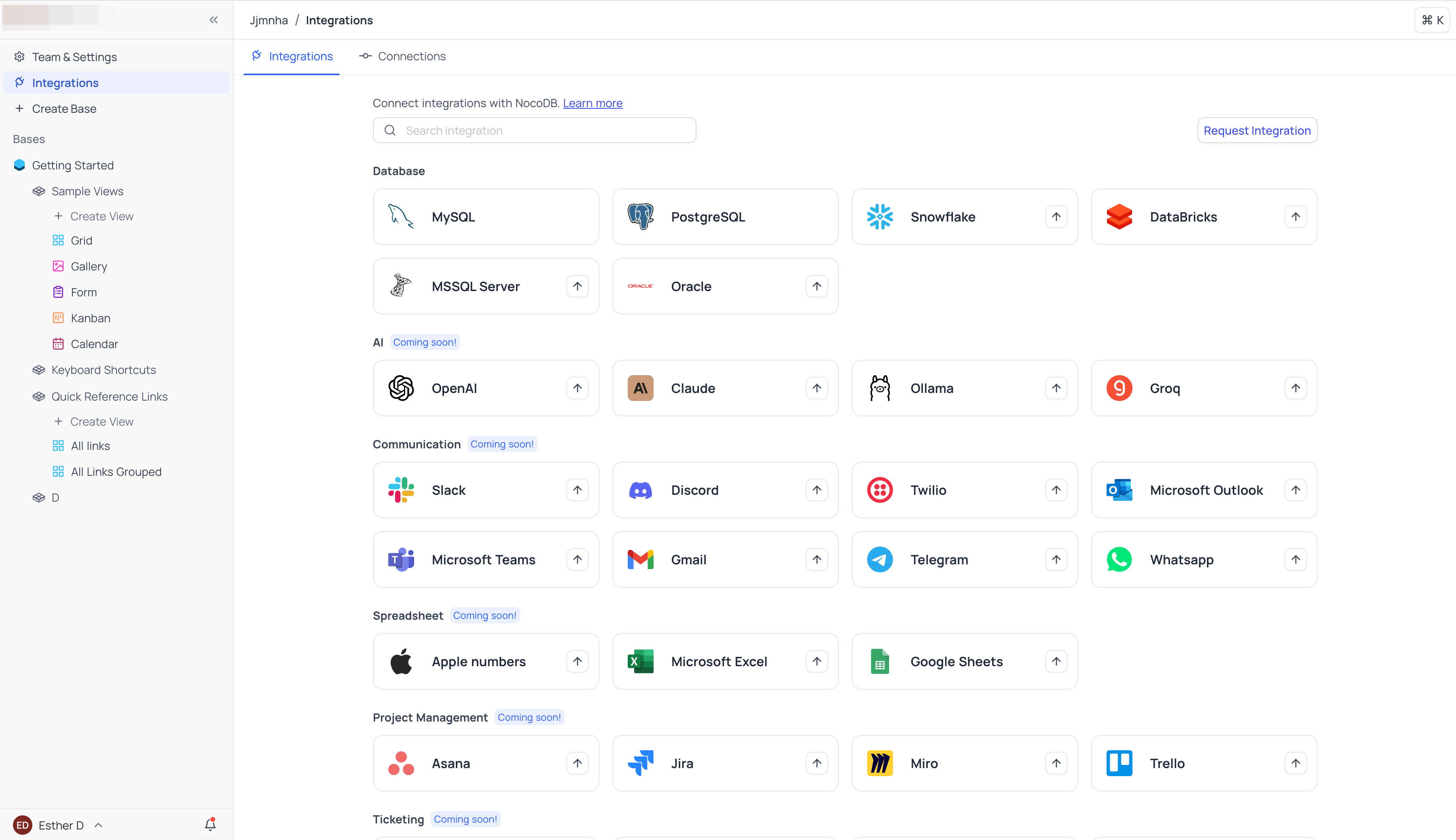
NocoDB also supports some level of extension, primarily focused on database connections and data synchronization. However, compared to NocoBase, it offers fewer plugin options, making it less adaptable to various business needs.
User Experience Comparison
User experience plays a key role in determining a tool's usability and widespread adoption. Whether for beginners or experienced developers, factors like the learning curve, interface design, and mobile support are crucial.
Here, we compare NocoBase and NocoDB from these three parts.
Learning Curve
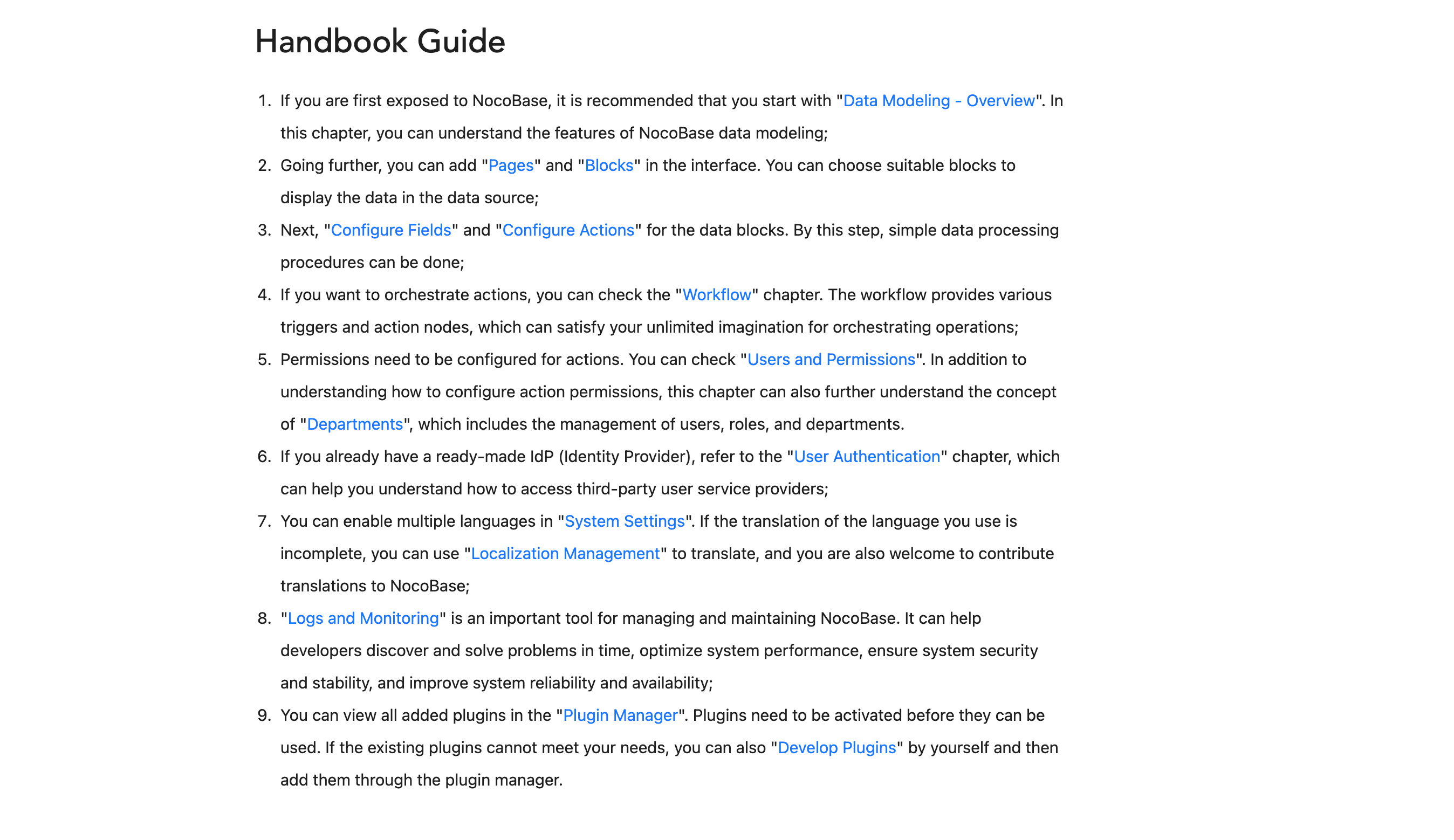
NocoBase has a relatively gentle learning curve, thanks to its intuitive interface and clear operation guides. Users can get started quickly, and NocoBase also offers comprehensive documentation and tutorials (which are continually improving), helping users gradually master advanced features. For those who need deeper customization, NocoBase provides open extension interfaces, making it suitable for users of different skill levels.
Some users with basic computer knowledge have told us that they were able to start designing business processes within just three days.
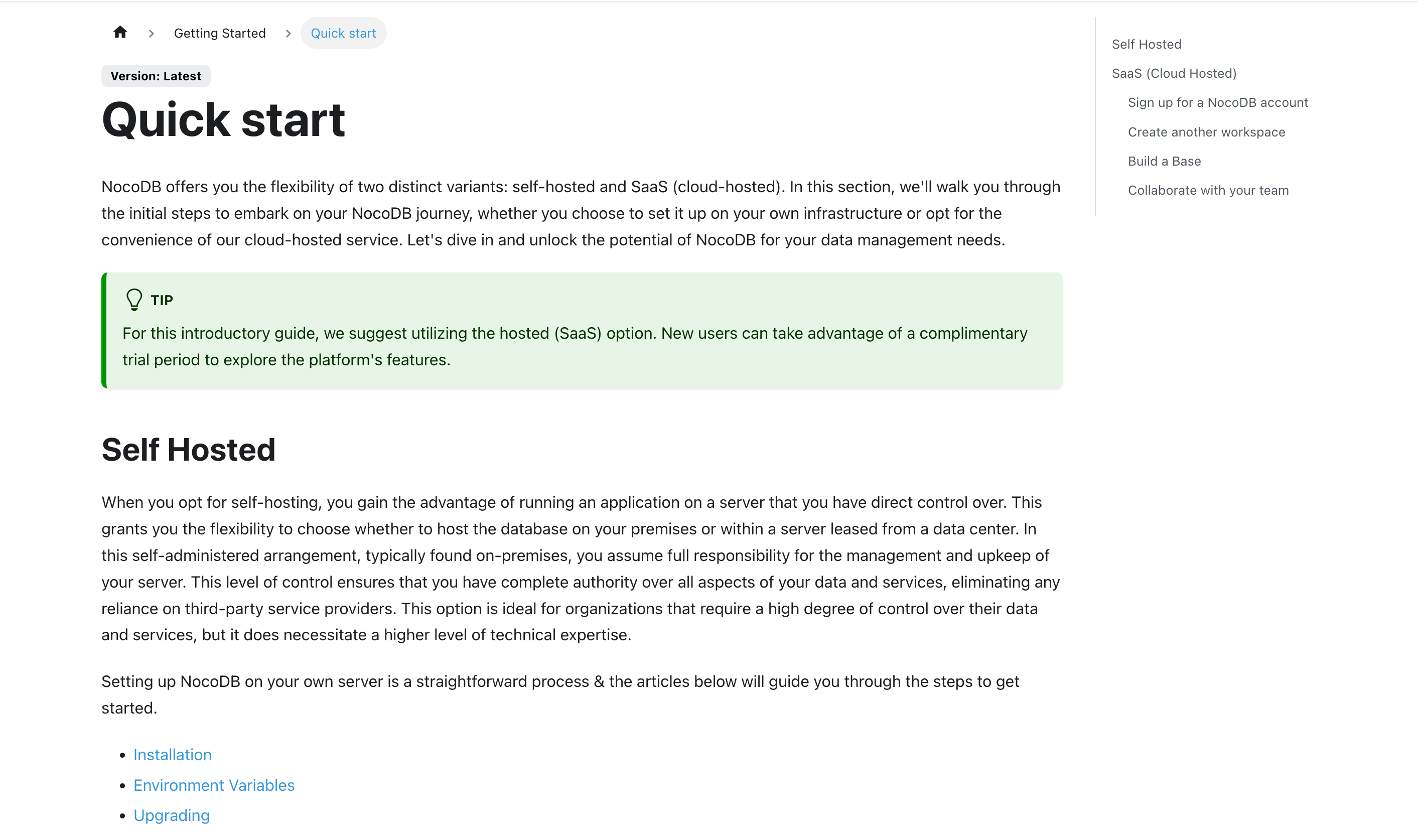
The no-code interface of NocoDB is also very simple, making it suitable for users without any database operation experience. You can manage databases through simple clicks and configurations without needing to deeply understand database concepts or write complex SQL queries. At the same time, for users with database experience, NocoDB offers flexible database management features, enabling efficient handling of existing database operations.
Interface Design
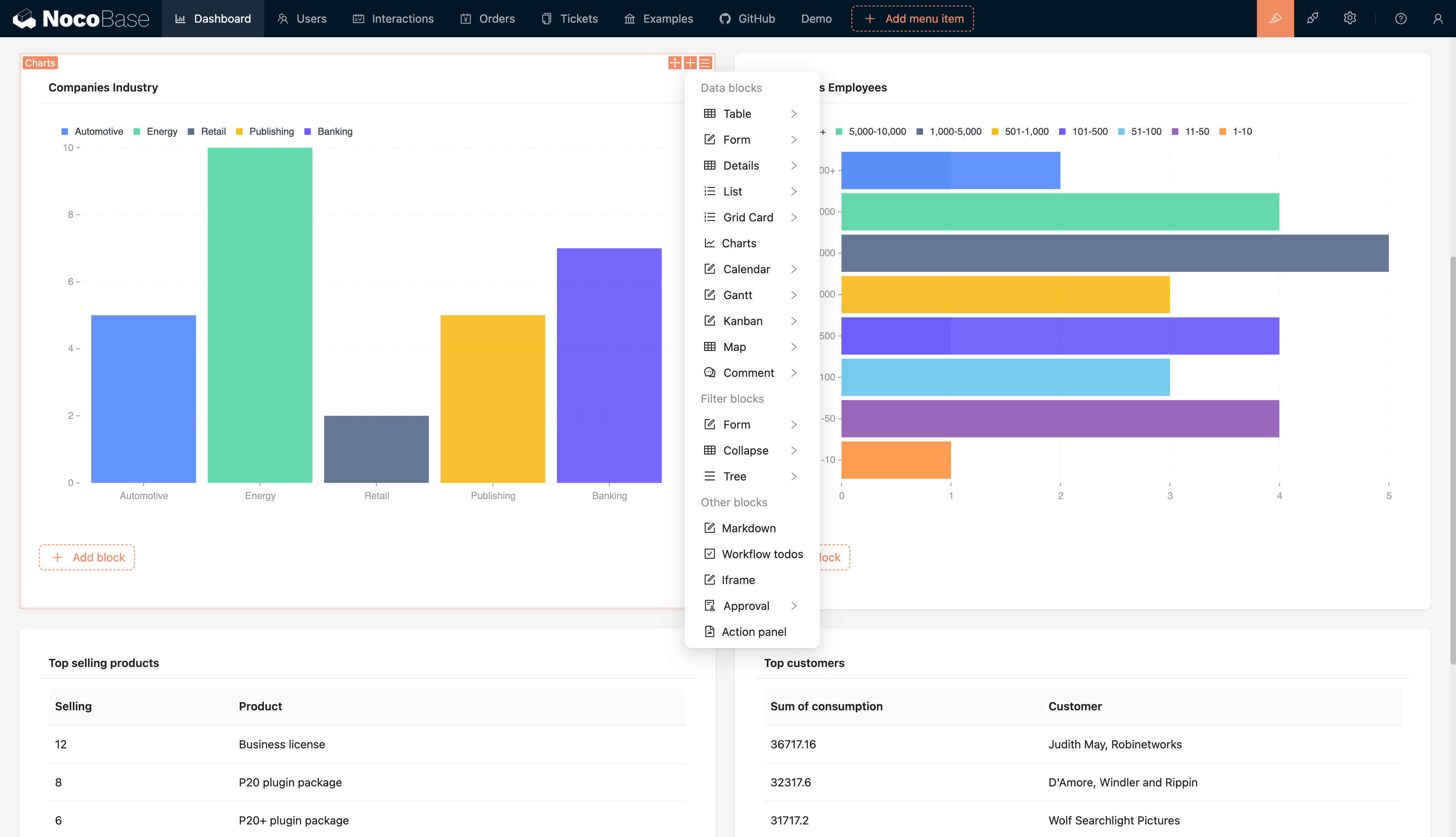
NocoBase focuses on user experience in its interface design, offering a WYSIWYG (What You See Is What You Get) experience. Whether designing application pages or managing data, NocoBase provides clear navigation and rich interactive elements, making it easy to find the features you need. Additionally, its visual page design tool allows users to freely customize the interface, enhancing the overall user experience and aesthetic.
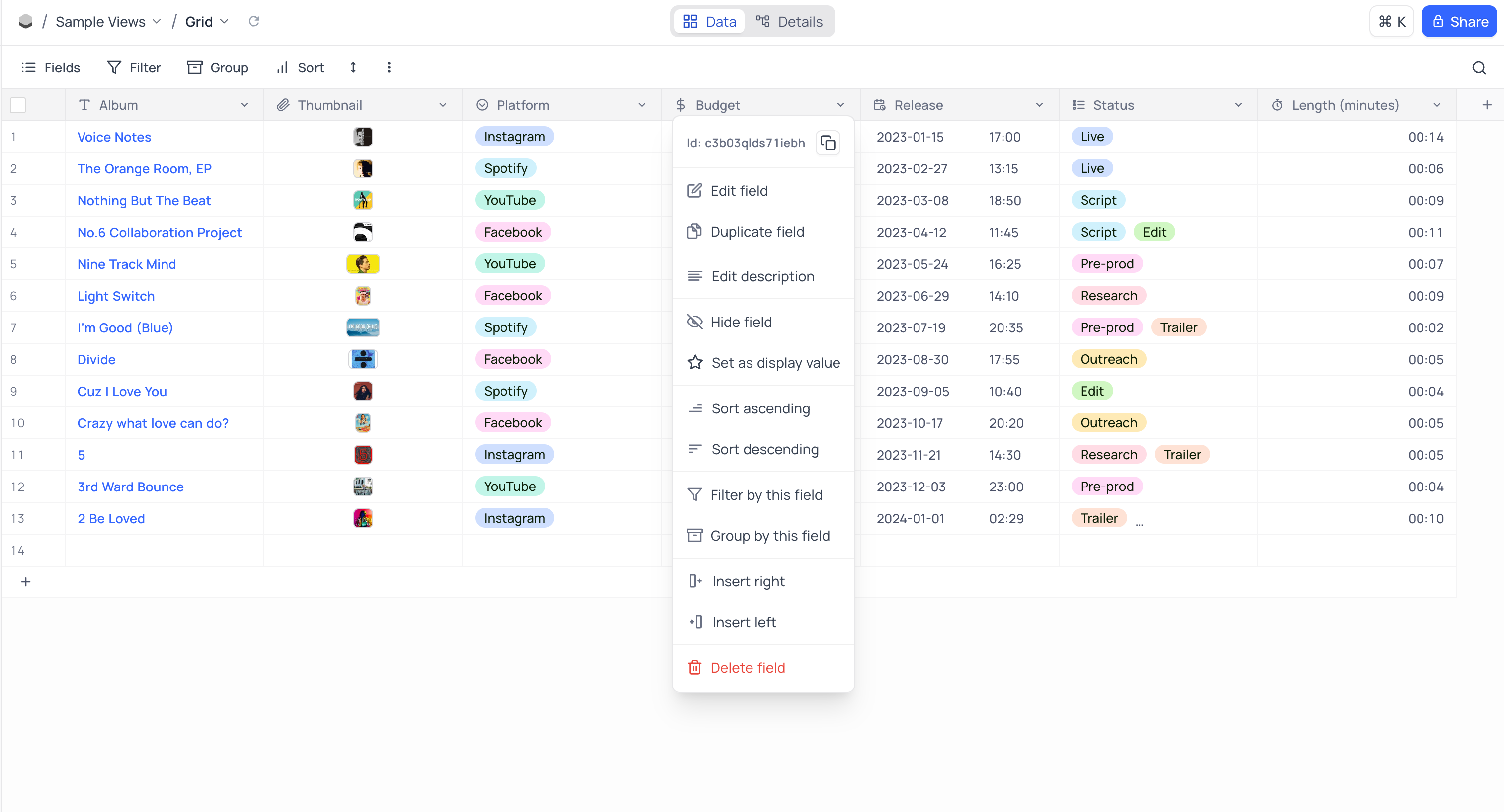
NocoDB’s interface is more functional, focusing primarily on grid-based data management. While it’s clean and straightforward, it’s not as intuitive as NocoBase for users who need customization or visual appeal.
Mobile Support
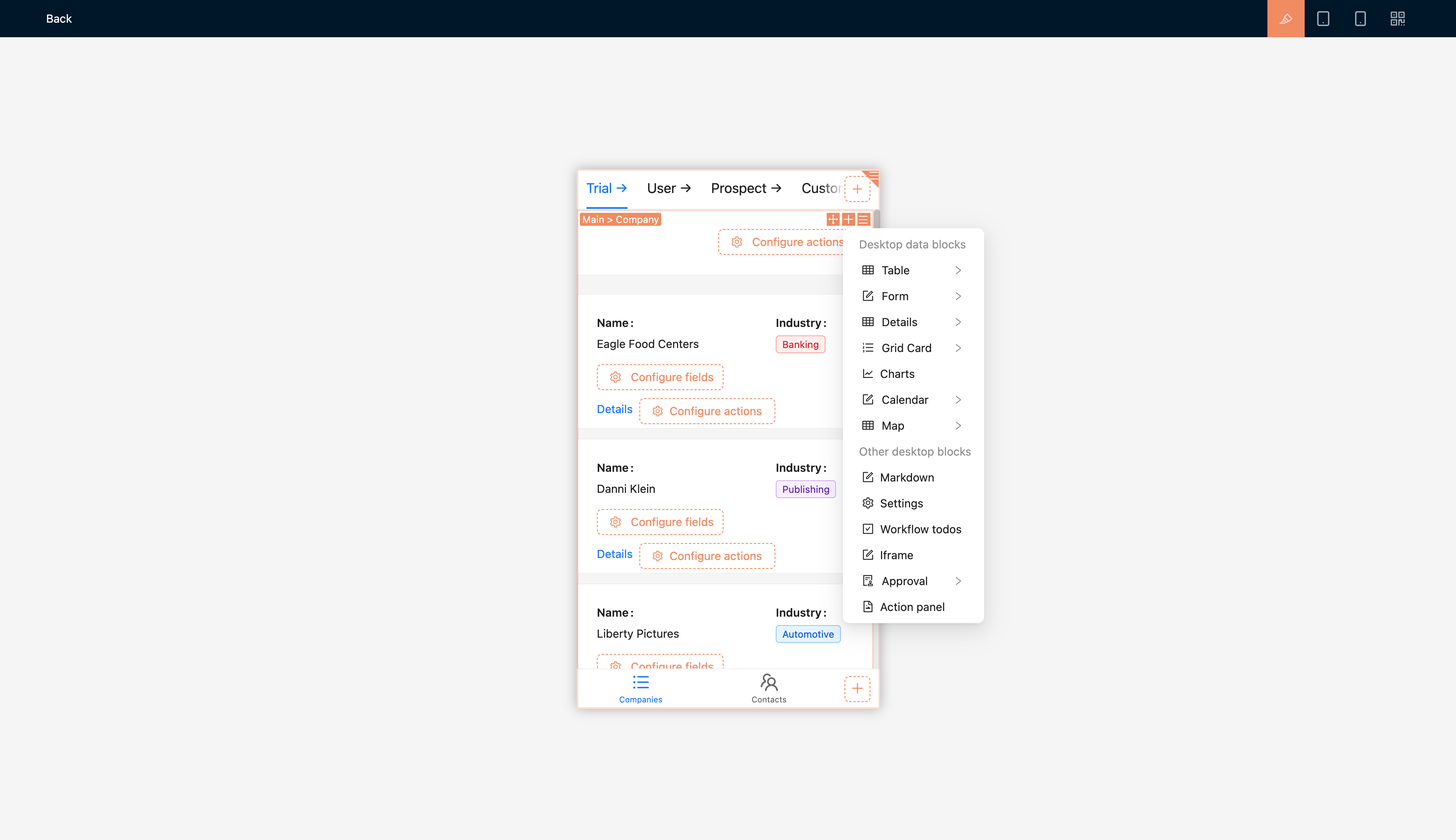
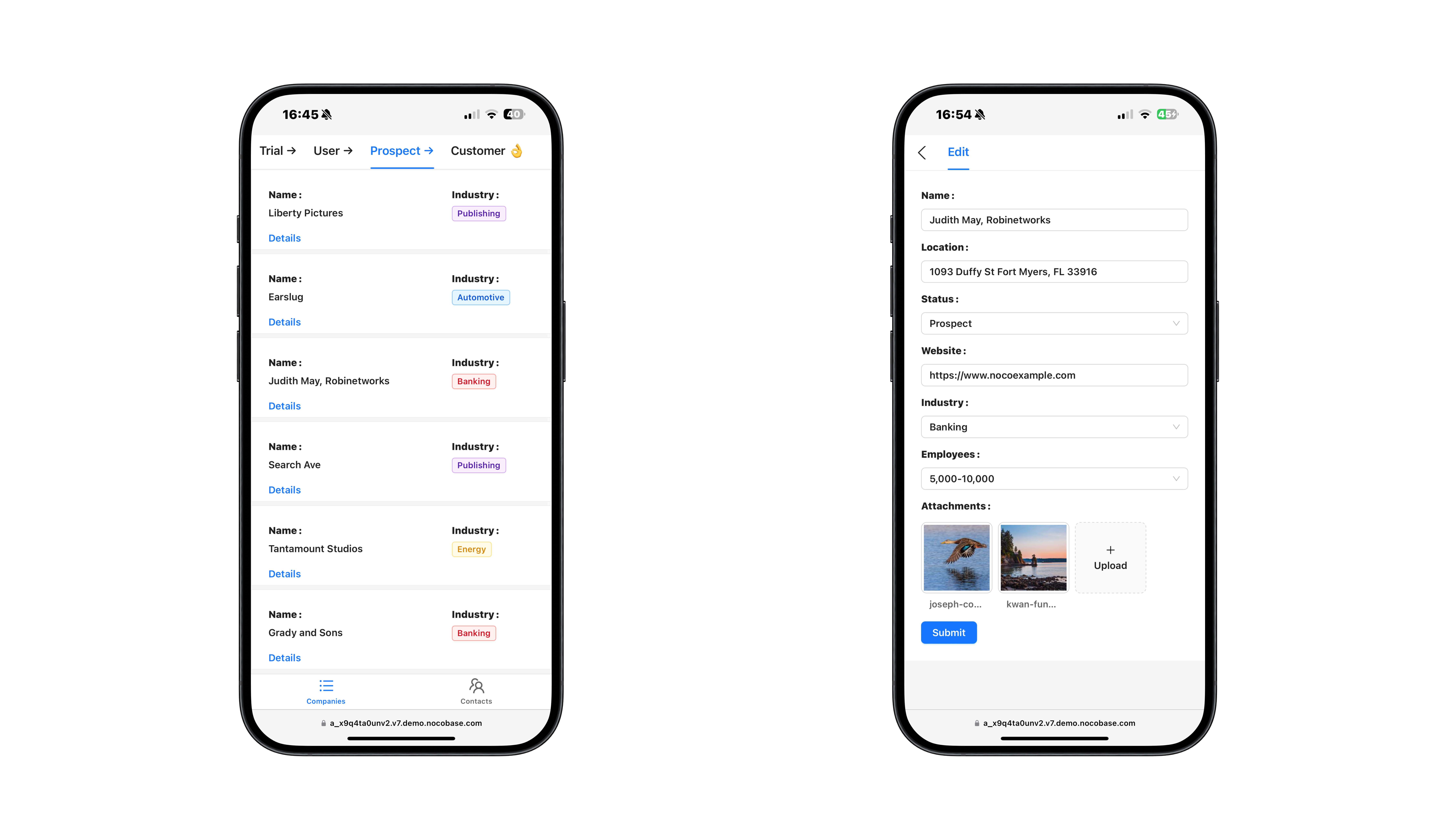
NocoBase recently released version 2.0 for mobile, allowing users to configure mobile pages separately and ensuring a smooth experience on various screen sizes. The mobile version also supports menu access permissions similar to the desktop version.
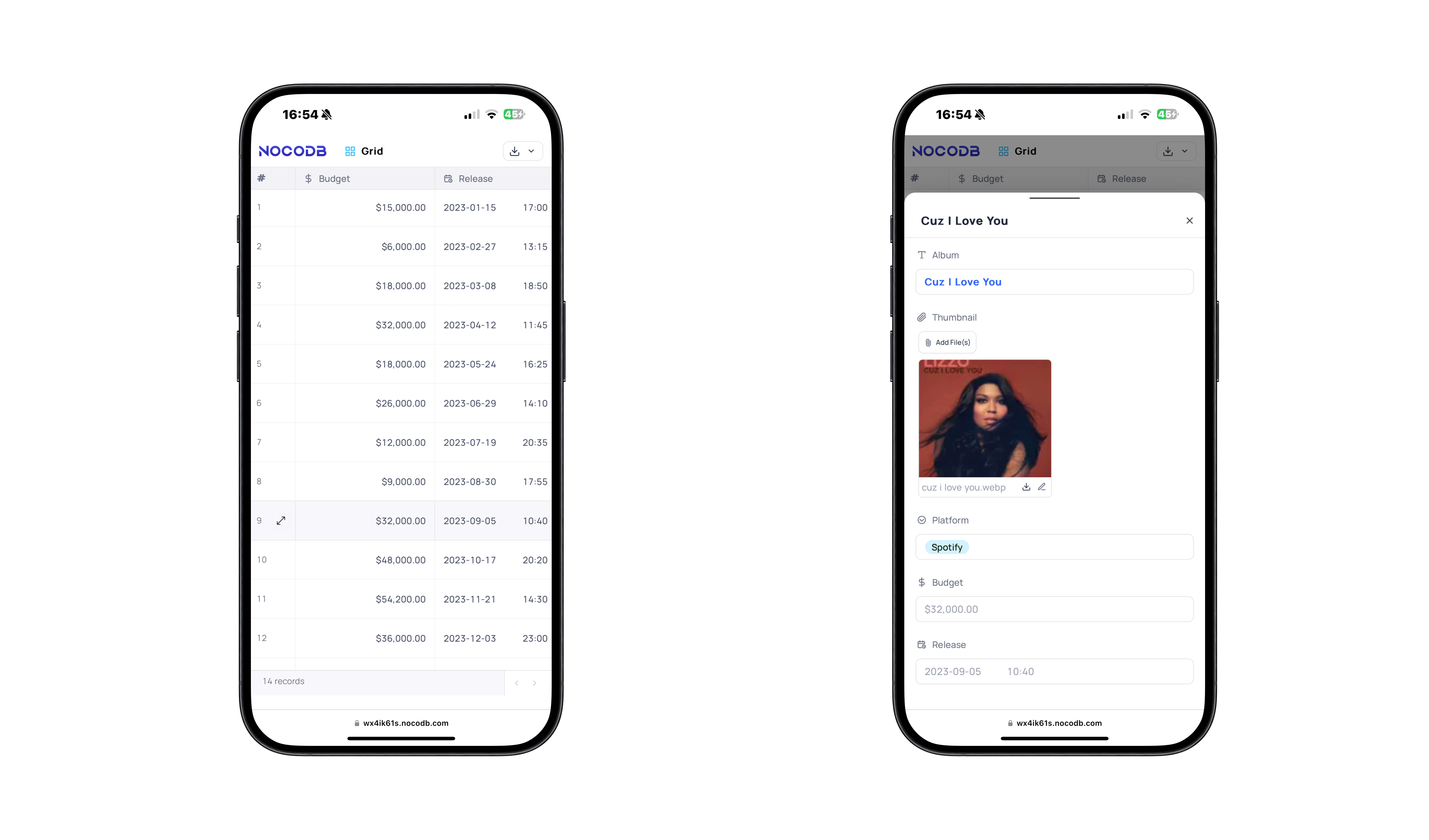
NocoDB’s mobile support is basic. While it can be accessed on mobile devices, its interface is primarily designed for desktop use.
Application Integration Capabilities
When choosing a no-code tool, many users are particularly concerned about its integration capabilities, especially for teams that need to seamlessly integrate new tools with existing systems. Here, we'll compare NocoBase and NocoDB in terms of API support and third-party integrations.
API Support
NocoBase
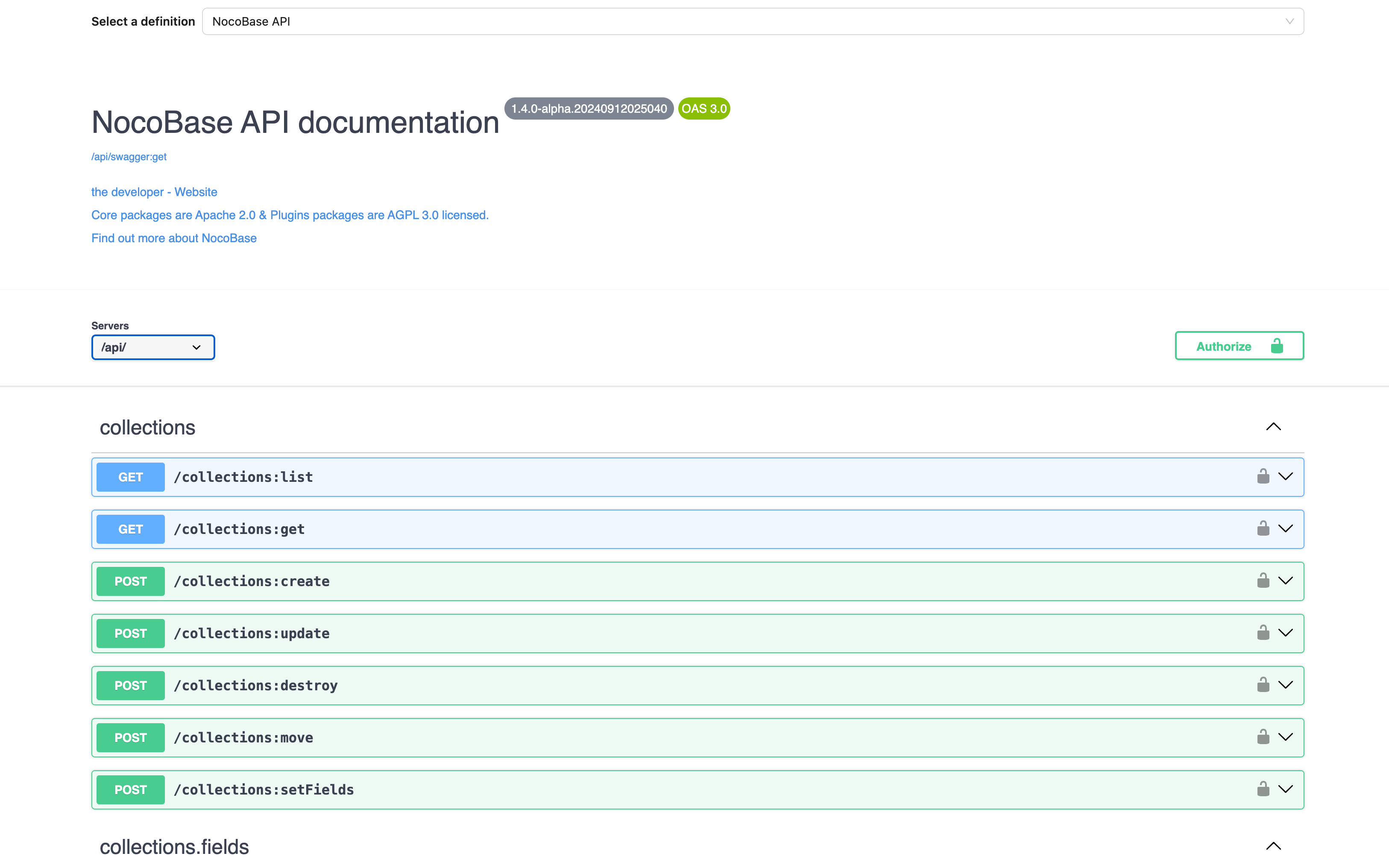
NocoDB
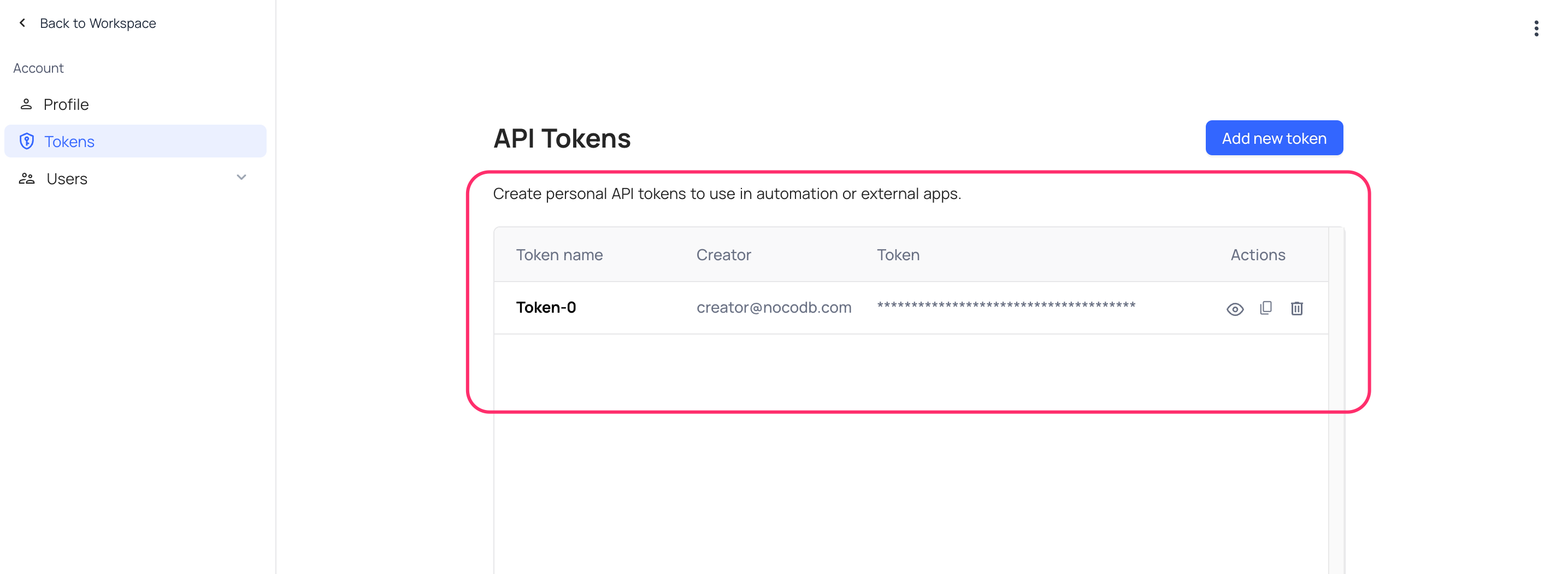
Both NocoBase and NocoDB perform well in terms of API support, offering open APIs that allow users to integrate them with other applications or systems. Users can read and write data through the API, create custom integrations, and meet more complex business needs. Both tools provide sufficient openness in their APIs to support automation and external system connections.
Third-Party Integrations
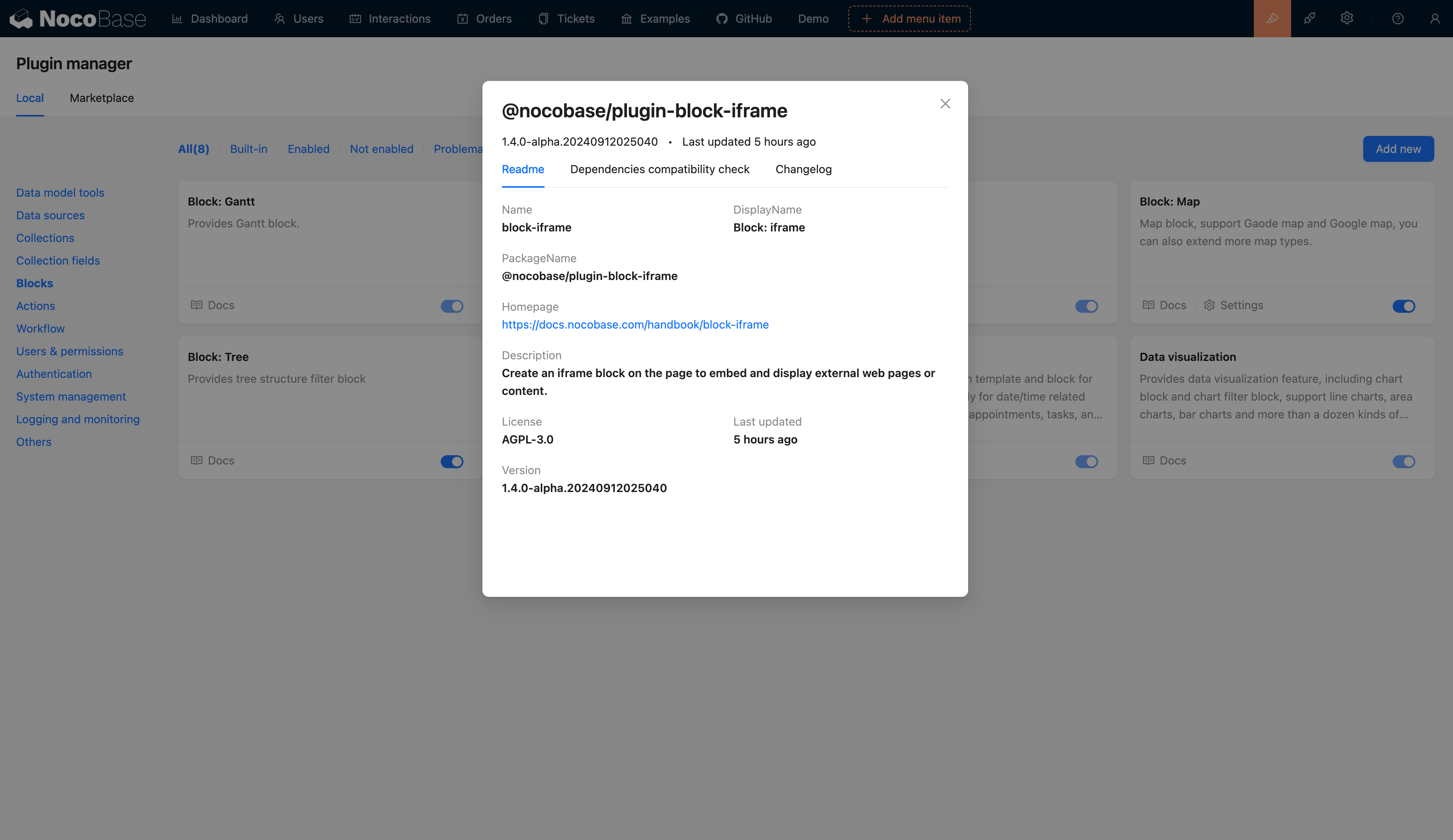
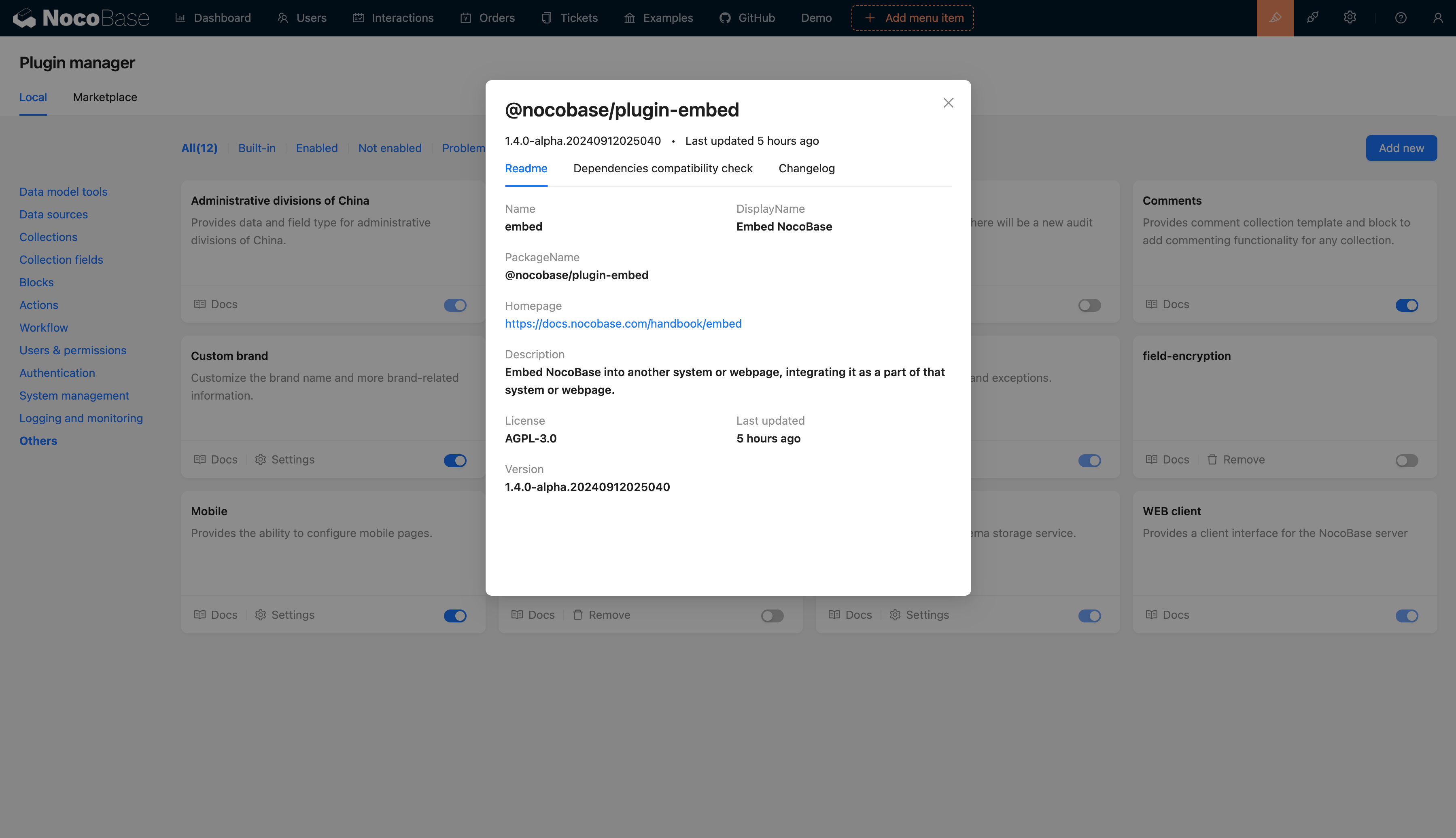
NocoBase is more flexible and comprehensive when it comes to third-party integrations. Thanks to its plugin-based architecture, users can easily integrate it with various third-party services through plugins.(Iframe Block and Embed NocoBase) It even allows users to develop custom integration plugins, greatly expanding its potential.
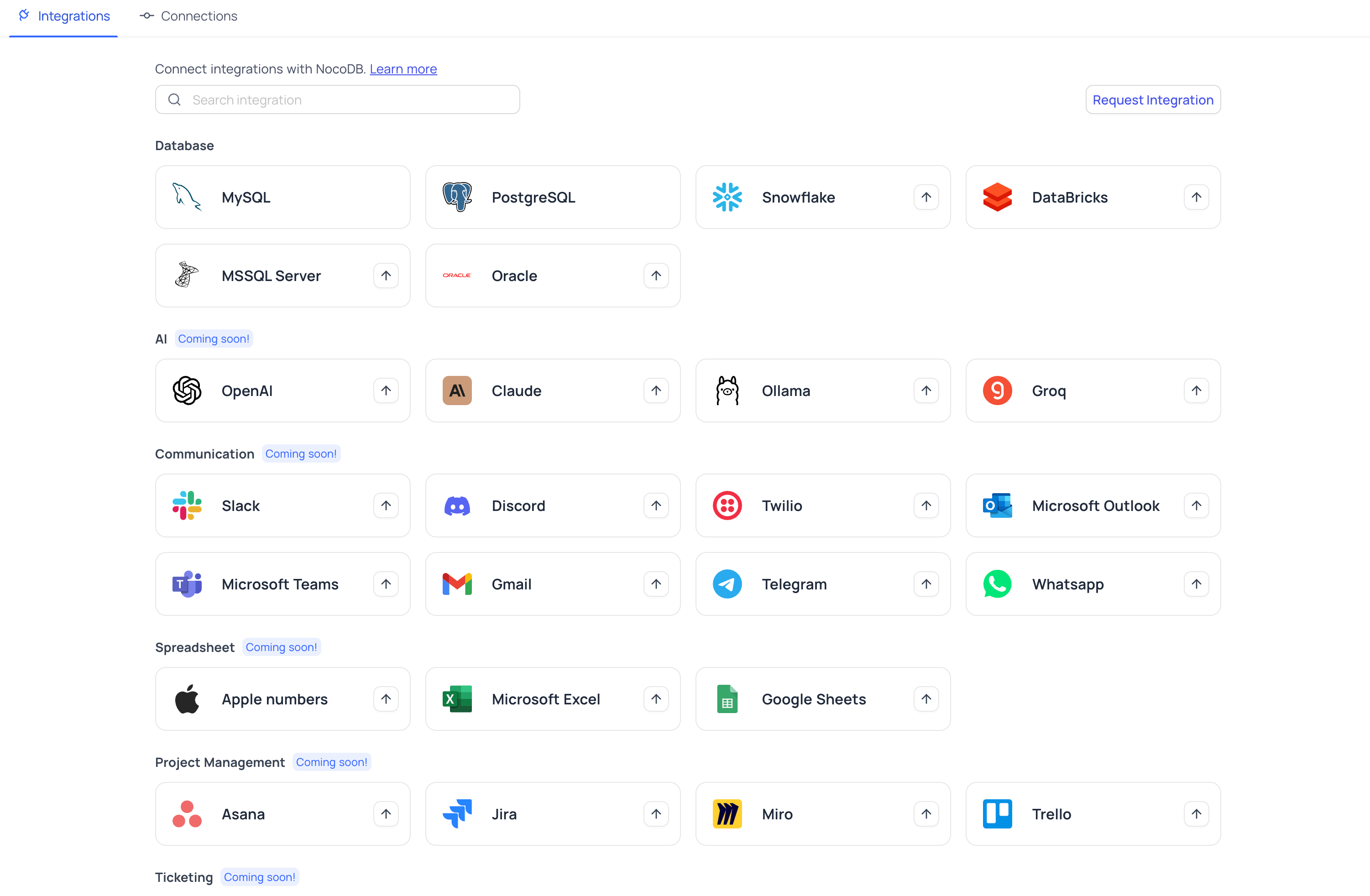
NocoDB, while not as extensive as NocoBase in terms of third-party integration, excels in data synchronization and database integration. NocoDB easily connects with common databases like MySQL and PostgreSQL, and enables data exchange with other applications via REST APIs. Its integrations focus more on database management, making it suitable for users who need to unify multiple database resources.
Security
Security is a top priority for enterprise users, especially when dealing with sensitive data. A good access control mechanism ensures that different users and roles can only access the data they are authorized to. Let’s compare NocoBase and NocoDB in terms of access control.
Access Control
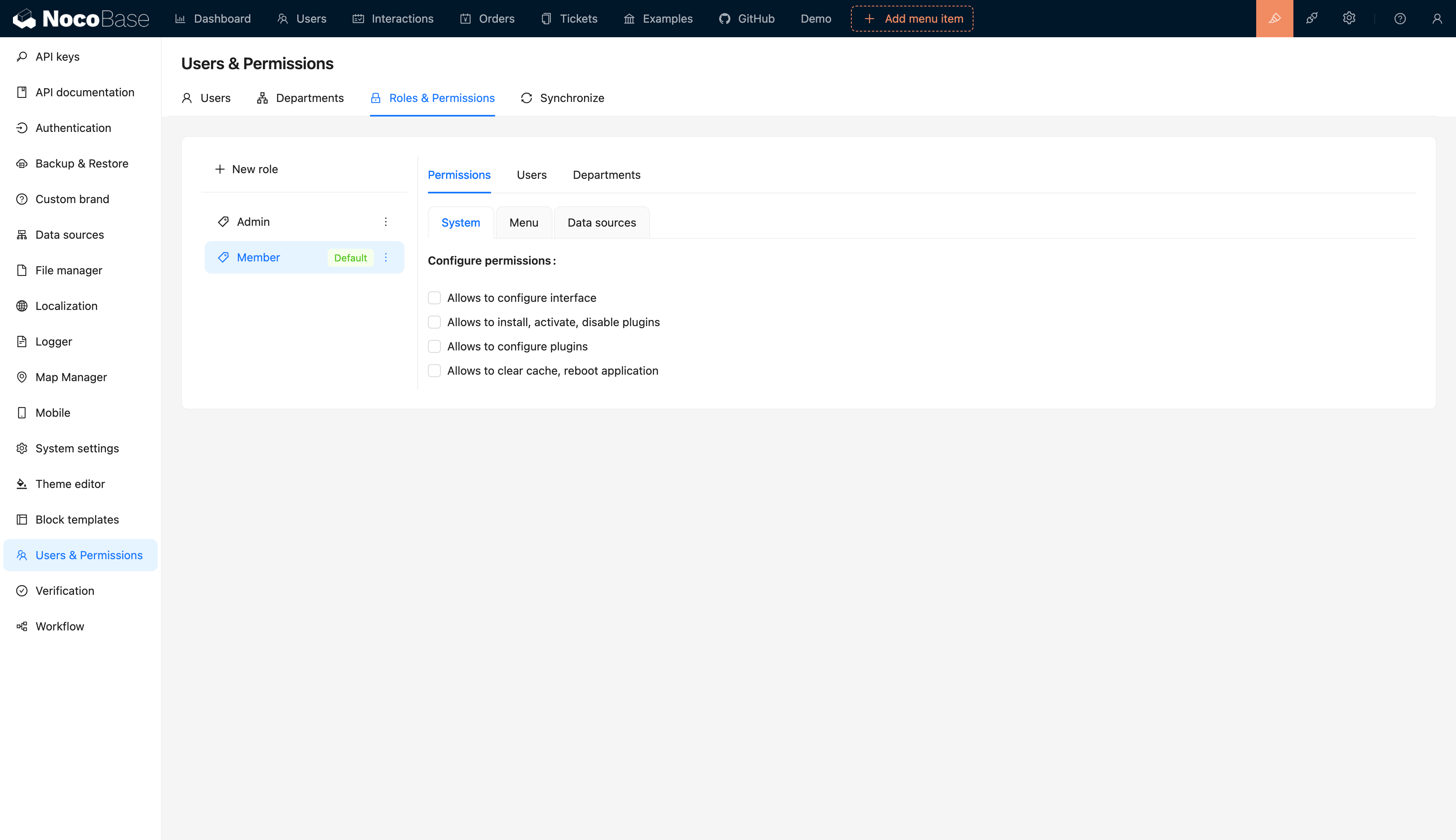
NocoBase offers a very flexible and comprehensive access control solution. From page-level access permissions to table-level permission settings, administrators can finely control access rights based on user roles and specific data.
NocoBase’s powerful permission features allow users to configure access rules based on roles, users, and even specific data content. This granular control not only protects sensitive data but also ensures that users have the appropriate permissions when operating the system, enhancing overall security and operability.
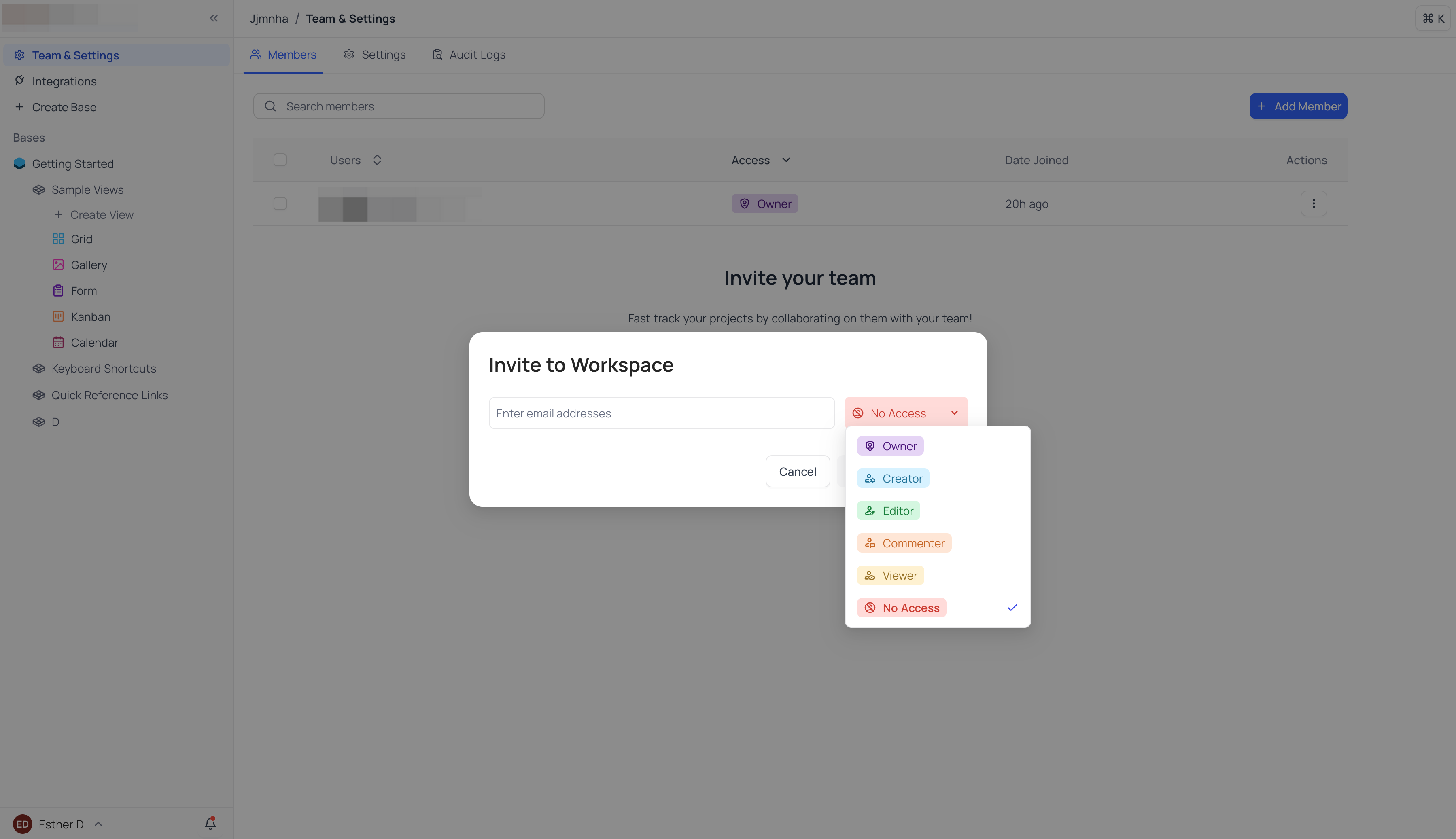
NocoDB’s access control is more basic. It provides simple role-based permission settings, allowing users to assign data operation permissions based on different roles. While this straightforward approach is easy to implement, it lacks the flexibility needed for complex multi-user and multi-role scenarios. For small teams or individual projects, NocoDB’s simplicity is an advantage, as it allows for quick permission configuration without spending too much time on complex setups.
In summary, NocoBase excels in access control flexibility and depth, making it suitable for scenarios with high data security requirements, while NocoDB offers simpler, easier-to-use permission management for less complex data management needs.
Enterprise Features
In enterprise environments, application tools need to be not only stable and efficient but also capable of handling large-scale users and offering customization features to meet business needs. We’ll compare NocoBase and NocoDB on two key points: large-scale user management and custom branding.
Large-Scale User Management
NocoBase maintains system stability and responsiveness even when handling large user datasets. Based on actual usage tests, NocoBase can smoothly manage up to 30,000 users' form data, efficiently completing tasks like querying, filtering, and batch operations. This makes NocoBase an ideal solution for business scenarios that need to manage a large number of users, such as CRM systems or membership management platforms.
NocoDB’s performance in large-scale user management is unknown.(Feel free to add if you've tried it!)
Custom Branding
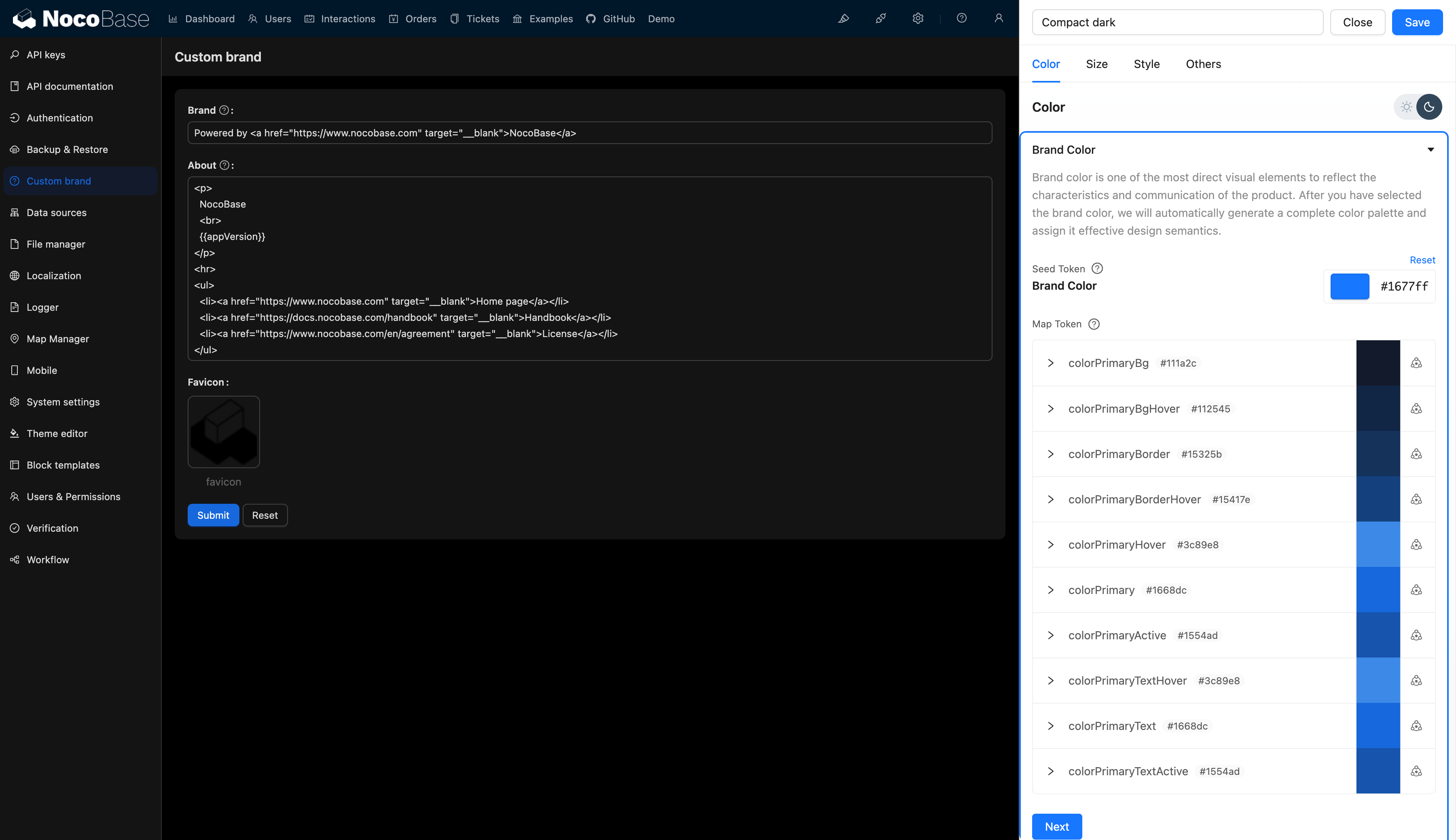
NocoBase provides rich customization features for branding, allowing enterprises to tailor the system interface, login pages, and more to match their brand image. With simple configurations, users can adjust NocoBase’s appearance to fit the style of their business, enhancing professionalism and consistency. This is particularly important for enterprises that need to integrate no-code tools into existing business systems, as it strengthens user recognition and maintains brand consistency.
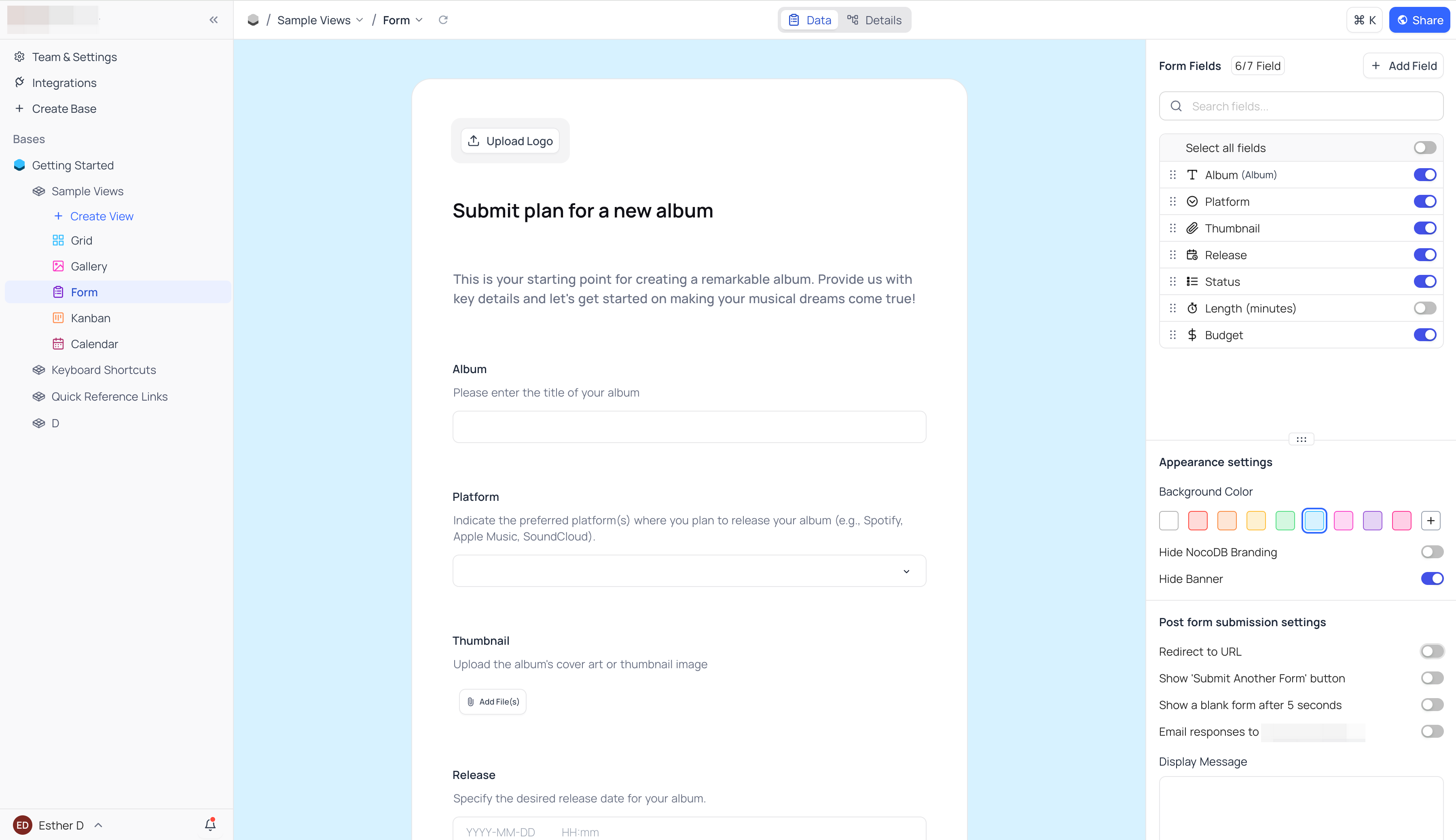
In contrast, NocoDB offers limited custom branding features. It allows basic color settings and logo uploads for forms, which may be enough for projects that don’t require extensive brand customization. For teams or individuals with simpler branding needs, NocoDB’s minimal interface may suffice.
Data Integration Capabilities
Data integration plays a critical role in determining the adaptability of no-code tools, whether it's compatibility with existing systems or ease of data migration. Let’s compare NocoBase and NocoDB in terms of enterprise system integration and data migration tools.
Enterprise System Integration
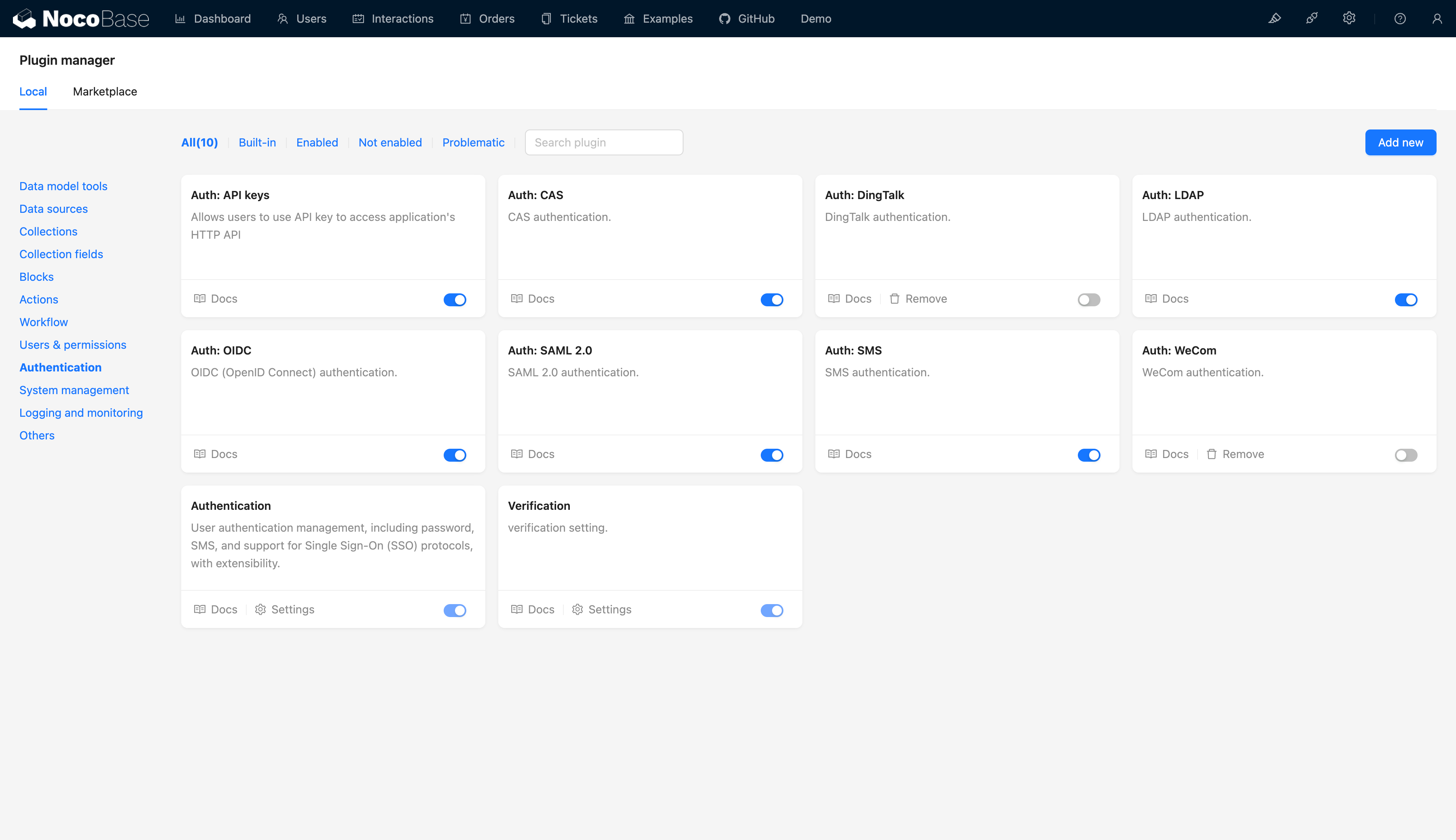
NocoBase demonstrates strong capabilities in integrating with enterprise systems. It offers a variety of account integration plugins and supports multiple enterprise-level authentication protocols and systems, such as CAS, OIDC, SAML 2.0, and LDAP. These standard protocols allow NocoBase to seamlessly integrate with existing enterprise authentication and permission management systems.
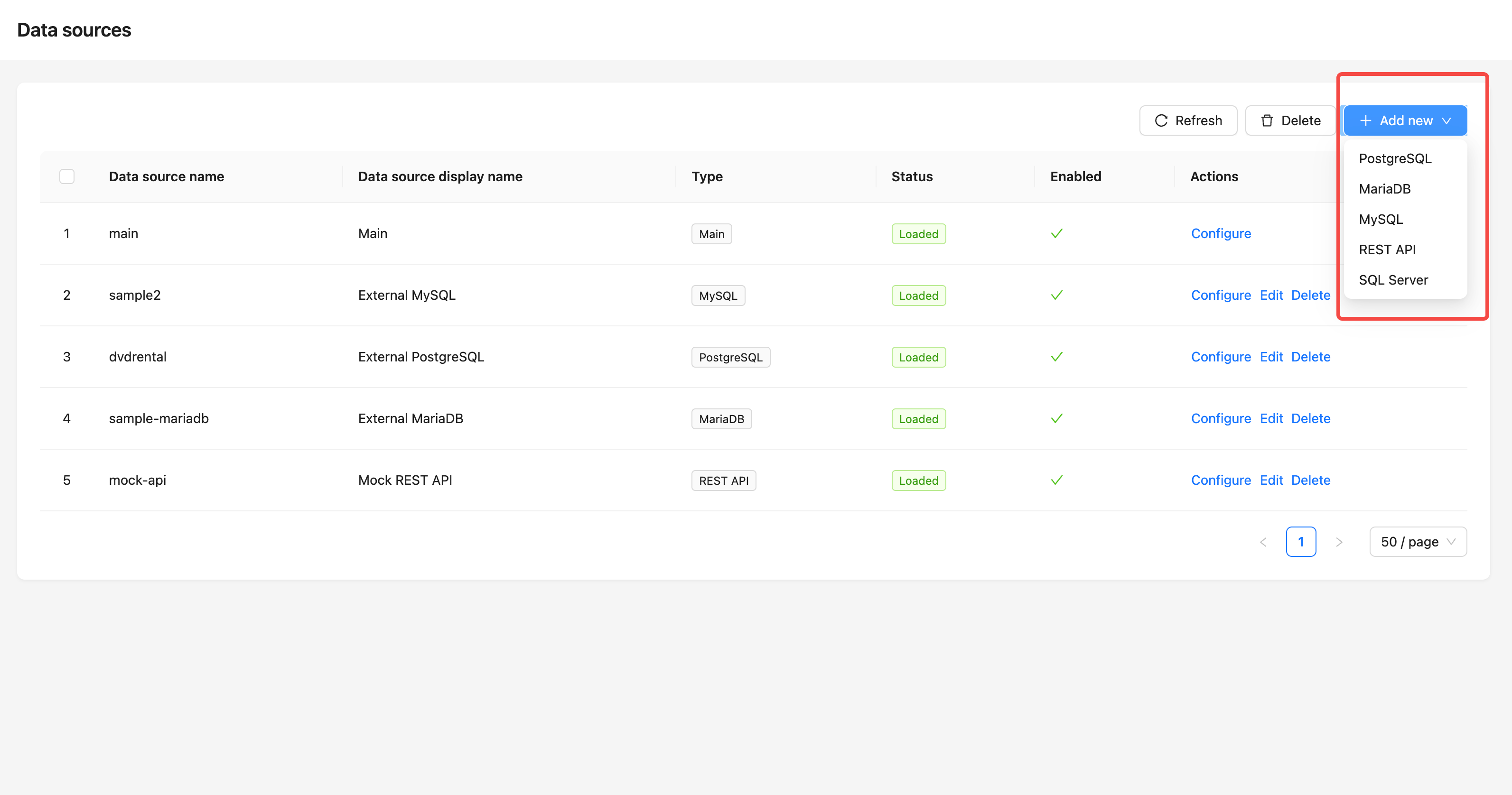
Furthermore, NocoBase offers rich database plugins that are compatible with various types of databases, such as MySQL, PostgreSQL, and SQLite. This makes it easy for enterprises to integrate NocoBase with their existing database systems, reducing the complexity of data conversion and ensuring consistency and stability.
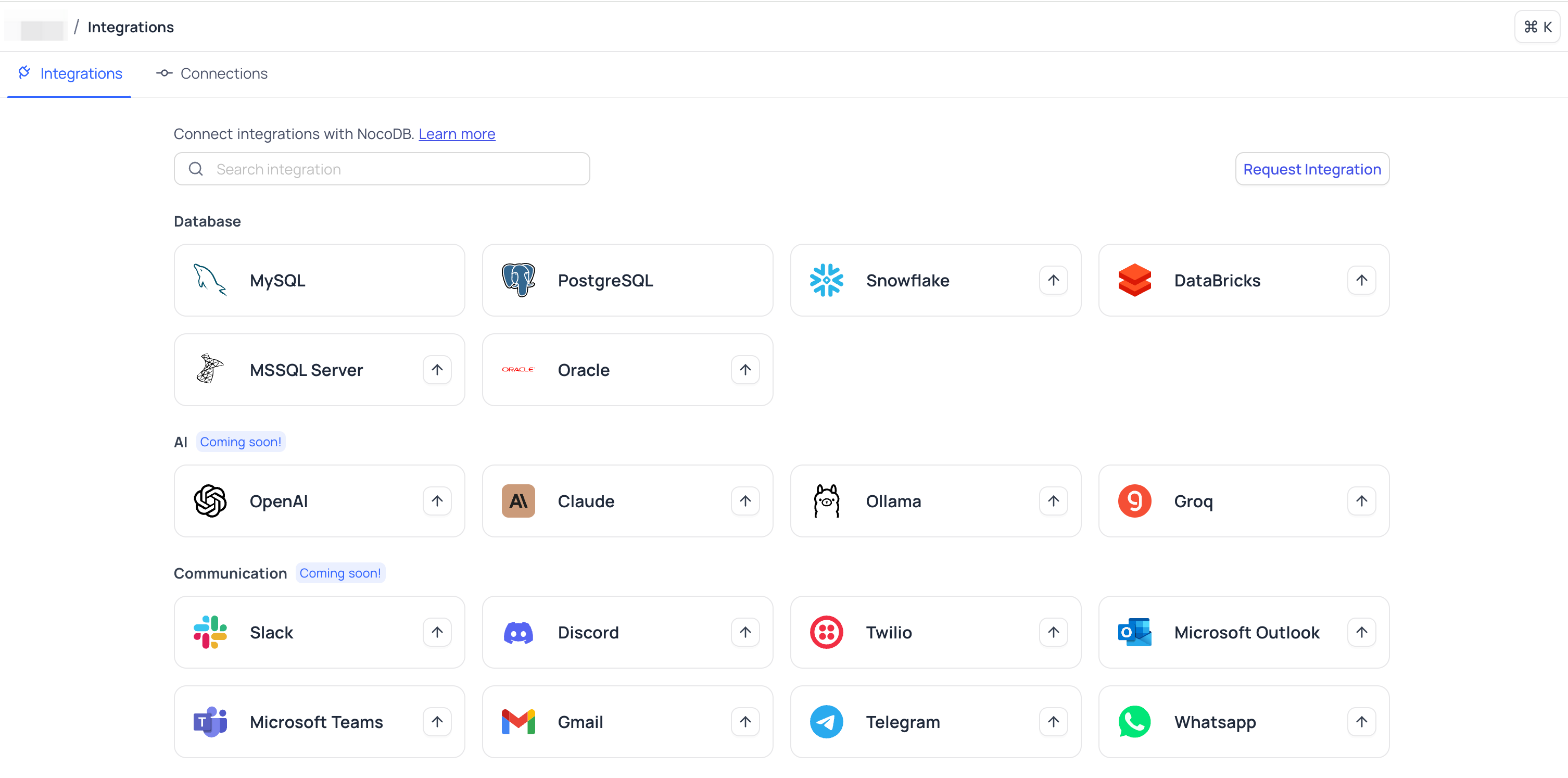
NocoDB’s enterprise system integration features are more basic. While it supports common database types and basic REST API integration, it lacks the depth of enterprise authentication protocols and system integrations that NocoBase provides. For users who need deep integration with enterprise systems, NocoDB may have limited options, and is more suitable for those already using standard database management systems.
Data Migration Tools
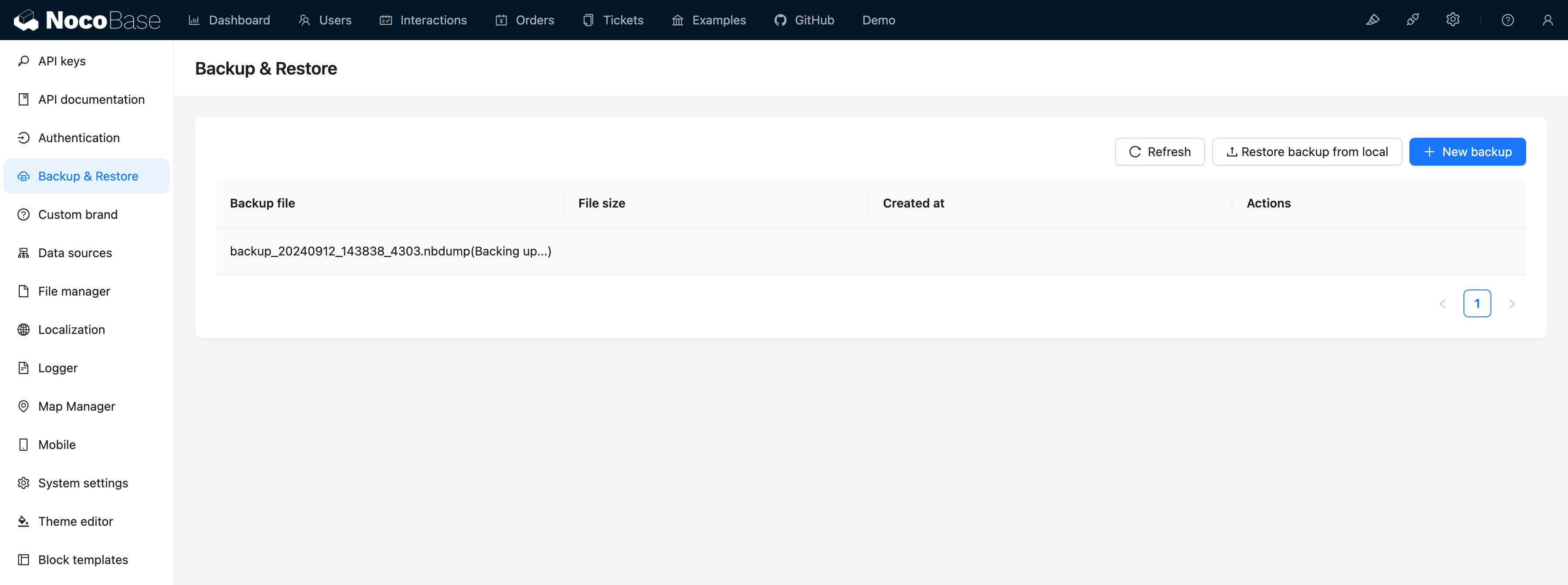
NocoBase offers convenient and secure data migration solutions. With built-in backup and restore plugins, users can easily duplicate, migrate, or upgrade applications, ensuring data safety during transitions.
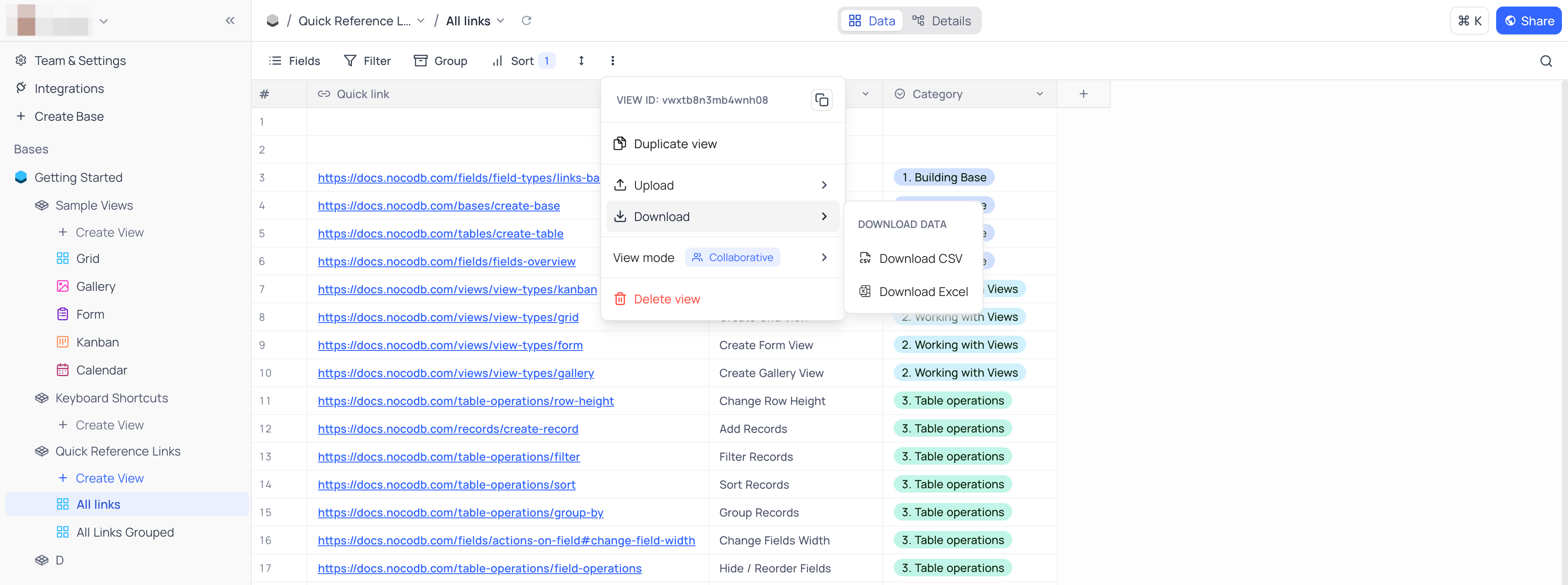
NocoDB relies primarily on manual database import and export operations for data migration. While this method meets basic migration needs, it may lack the automation and security features that NocoBase offers when dealing with large-scale data or complex applications.
Conclusion: Best Use Cases for Each Product
NocoBase offers a rich feature set and powerful enterprise-level capabilities, making it ideal for users who need to build complex business applications and integrate with various enterprise systems. Its strengths include:
A strong data model-driven and flexible system, suited for managing complex business processes.
High performance and load-balancing capabilities, allowing it to handle large-scale user data and high concurrency scenarios.
Comprehensive enterprise system integration (e.g., CAS, OIDC, LDAP) and third-party plugins, making it ideal for enterprises needing deep system integration.
Custom branding features and backup/restore plugins ensure high security and ease of operation in enterprise environments.
Best Use Cases: Enterprises looking to build complex business applications, manage large user or data sets, and integrate deeply with existing systems and databases will find NocoBase to be the best choice. It’s ideal for enterprises seeking a stable, high-performance, and scalable no-code platform.
NocoDB is more like a database management tool, focused on transforming relational databases into more user-friendly, spreadsheet-like interfaces. Its characteristics include:
Simple operations and basic form functionality, making it suitable for quick database management.
A flexible front-end and back-end design, ideal for small-scale data management and simple database applications.
Open API capabilities, though it may fall short in load handling and high-performance processing.
Best Use Cases: NocoDB is perfect for lightweight database management and simple application scenarios, particularly for users with existing databases who want a quick, no-code way to manage and operate data. It’s a good choice for small teams or individual developers with straightforward needs.
In summary, if you need a highly flexible, powerful tool suitable for enterprise applications, NocoBase is the better option. However, if your primary need is lightweight database management without complex integration features, NocoDB is a simple and efficient solution.
😁Lastly, feel free to try out both of these open-source no-code tools yourself. If you found this article helpful, don’t hesitate to share it with others. Thank you for reading!
Related reading:
Subscribe to my newsletter
Read articles from Lucy Zhang directly inside your inbox. Subscribe to the newsletter, and don't miss out.
Written by
